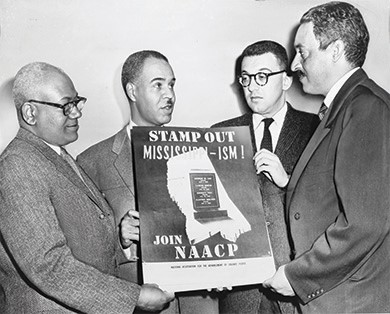12 Chapter 12: Post-War Prosperity, Cold War Fears, and the Struggle for Equality, 1945-1968
Post-War Prosperity, Cold War Fears, and the Struggle for Equality, 1945-1968

Is This Tomorrow? warned Americans about the potential horrors of living under a Communist dictatorship. Postwar propaganda such as this comic book, the cover of which showed invading Russians attacking Americans and the U.S. flag in flames, served to drum up fear during the Cold War. Source: Wikimedia Commons
Chapter Outline
Introduction, Watch and Learn, Questions to Guide Your Reading
12.1 The Challenges of Peacetime
12.2 The Cold War
12.3 The American Dream
12.4 Popular Culture and Mass Media
12.5 The African American Struggle for Civil Rights
12.6 The Kennedy Promise
12.7 Lyndon Johnson and the Great Society
12.8 The Civil Rights Movement Marches On
12.9 Challenging the Status Quo
Summary Timelines, Chapter 12 Self-Test, Chapter 12 Key Terms Crossword Puzzle
Introduction
Is This Tomorrow?, a 1947 comic book, highlights one way that the federal government and some Americans revived popular sentiment in opposition to Communism. The United States and the Soviet Union, allies during World War II, had different visions for the postwar world. As Joseph Stalin, premier of the Soviet Union, tightened his grip on the countries of Eastern Europe, Americans began to fear that it was his goal to spread the Communist revolution throughout the world and make newly independent nations puppets of the Soviet Union. To enlist as many Americans as possible in the fight against Soviet domination, the U.S. government and purveyors of popular culture churned out propaganda intended to convince average citizens of the dangers posed by the Soviet Union. Artwork such as the cover of Is This Tomorrow?, which depicts Russians attacking Americans, including a struggling woman and an African American veteran still wearing his uniform, played upon postwar fears of Communism and of a future war with the Soviet Union. These fears dominated American life and affected foreign policy, military strategy, urban planning, popular culture, and the civil rights movement in the late 1940s and into the 1950s.
The 1960s was a decade of hope, change, and war that witnessed an important shift in American culture. Citizens from all walks of life sought to expand the meaning of the American promise. Their efforts helped unravel the national consensus and laid bare a far more fragmented society. As a result, men and women from all ethnic groups attempted to reform American society to make it more equitable. The United States also began to take unprecedented steps to exert what it believed to be a positive influence on the world. At the same time, the country’s role in Vietnam revealed the limits of military power and the contradictions of U.S. foreign policy. The posthumous portrait of John F. Kennedy captures this mix of the era’s promise and defeat. His election encouraged many to work for a better future, for both the middle class and the marginalized. Kennedy’s running mate, Lyndon B. Johnson, also envisioned a country characterized by the social and economic freedoms established during the New Deal years. Kennedy’s assassination in 1963, and the assassinations five years later of Martin Luther King, Jr. and Robert F. Kennedy, made it dramatically clear that not all Americans shared this vision of a more inclusive democracy.
Watch and Learn
- The Cold War
- The Cold War in Asia
- Civil Rights and the 1950s
- The 1960s in America
- School Segregation and Brown v. Board
- Emmet Till
- The Montgomery Bus Boycott
- Martin Luther King, Jr.
Questions to Guide Your Reading
- What was the reason for the breakdown in friendly relations between the United States and the Soviet Union after World War II? What were the results of this conflict?
- How did fear of the Soviet Union and Communism affect American culture and society?
- What social changes took place in the United States after World War II? What role did the war play in those changes? How did the wartime experiences of African Americans contribute to the drive for greater civil rights after the war?
- Describe the changing role of the federal government in the 1960s. What new roles and responsibilities did the government assume? In your opinion, can the government effect permanent social change? Why or why not?
- Discuss how and why various groups of people within American society began to challenge and criticize the nation’s way of life in the 1960s. Were their criticisms valid? What were some of the goals of these groups, and how did they go about achieving them?
- In your opinion, what is the most effective method for changing society—voting, challenges in the courts, nonviolent civil disobedience, or violence? What evidence can you provide from actual events in the 1960s to support your argument?
- Were groups that advocated the use of violence in the 1960s justified in doing so? Why or why not?
12.1 The Challenges of Peacetime
Learning Objectives
By the end of this section, you will be able to:
- Identify the issues that the nation faced during demobilization
- Explain the goals and objectives of the Truman administration
- Evaluate the actions taken by the U.S. government to address the concerns of returning veterans
The decade and a half immediately following the end of World War II was one in which middle- and working-class Americans hoped for a better life than the one they lived before the war. These hopes were tainted by fears of economic hardship, as many who experienced the Great Depression feared a return to economic decline. Others clamored for the opportunity to spend the savings they had accumulated through long hours on the job during the war when consumer goods were rarely available.
African Americans who had served in the armed forces and worked in the defense industry did not wish to return to “normal.” Instead, they wanted the same rights and opportunities that other Americans had. Still other citizens were less concerned with the economy or civil rights; instead, they looked with suspicion at the Soviet presence in Eastern Europe. What would happen now that the United States and the Soviet Union were no longer allies, and the other nations that had long helped maintain a balance of power were left seriously damaged by the war? Harry Truman, president for less than a year when the war ended, was charged with addressing all of these concerns and giving the American people a “fair deal.”
DEMOBILIZATION AND THE RETURN TO CIVILIAN LIFE
The most immediate task to be completed after World War II was demobilizing the military and reintegrating the veterans into civilian life. The United States sought to demobilize its armed forces as quickly as possible by reducing the size of the U.S. military from a high of 12 million in June 1945 to 1.5 million in June 1947. Soldiers and sailors were not the only ones dismissed from service. As the war drew to a close, millions of women working the jobs of men who had gone off to fight were dismissed by their employers, often because the demand for war materiel had declined and because government propaganda encouraged them to go home to make way for the returning troops. While most women workers surveyed at the end of the war wished to keep their jobs (75–90 percent, depending on the study), many did in fact leave them. Nevertheless, throughout the late 1940s and the 1950s, women continued to make up approximately one-third of the U.S. labor force.
Readjustment to postwar life was difficult for the returning troops. The U.S. Army estimated that as many of 20 percent of its casualties were psychological. Although many eagerly awaited their return to civilian status, others feared that they would not be able to resume a humdrum existence after the experience of fighting on the front lines. Veterans also worried that they wouldn’t find work and that civilian defense workers were better positioned to take advantage of the new jobs opening up in the peacetime economy. Some felt that their wives and children would not welcome their presence, and some children did indeed resent the return of fathers who threatened to disrupt the mother-child household. Those on the home front worried as well. Doctors warned fiancées, wives, and mothers that soldiers might return with psychological problems that would make them difficult to live with.
The GI Bill of Rights
Before the end of the war, Congress had passed one of the most significant and far-reaching pieces of legislation to ease veterans’ transition into civilian life: the Servicemen’s Readjustment Act, also known as the GI Bill. Every honorably discharged veteran who had seen active duty, but not necessarily combat, was eligible to receive a year’s worth of unemployment compensation. This provision not only calmed veterans’ fears regarding their ability to support themselves, but it also prevented large numbers of men—as well as some women—from suddenly entering a job market that did not have enough positions for them. Another way that the GI Bill averted a glut in the labor market was by giving returning veterans the opportunity to pursue an education; it paid for tuition at a college or vocational school and gave them a stipend to live on while they completed their studies.
The result was a dramatic increase in the number of students—especially male ones—enrolled in American colleges and universities. In 1940, only 5.5 percent of American men had a college degree. By 1950, that percentage had increased to 7.3 percent, as more than two million servicemen took advantage of the benefits offered by the GI Bill to complete college. The numbers continued to grow throughout the 1950s. Upon graduation, these men were prepared for skilled blue-collar or white-collar jobs that paved the way for many to enter the middle class. The creation of a well-educated, skilled labor force helped the U.S. economy as well. Other benefits offered by the GI Bill included low-interest loans to purchase homes or start small businesses.

President Franklin D. Roosevelt signed the Servicemen’s Readjustment Act, or GI Bill, on June 22, 1944, just weeks after the Allied invasion of Normandy, France, and more than a year before the end of the war. Source: Wikimedia Commons
However, not all veterans were able to take advantage of the GI Bill. African American veterans could use their educational benefits only to attend schools that accepted black students. The approximately nine thousand servicemen and women who were dishonorably discharged because they were gay or lesbian were ineligible for GI Bill benefits. Benefits for some Mexican American veterans, mainly in Texas, were also denied or delayed.
The Return of the Japanese
Japanese Americans from the West Coast who had been interned during the war confronted the task of rebuilding their lives. In December 1944, Franklin Roosevelt had declared an end to the forced relocation of Japanese Americans, and as of January 1945, they were free to return to their homes. In many areas, however, neighbors clung to their prejudices and denounced those of Japanese descent as disloyal and dangerous. These feelings had been worsened by wartime propaganda, which often featured horrific accounts of Japanese mistreatment of prisoners, and by the statements of military officers to the effect that the Japanese were inherently savage. Facing such animosity, many Japanese American families chose to move elsewhere. Those who did return often found that in their absence, “friends” and neighbors had sold possessions that had been left with them for safekeeping. Many homes had been vandalized and farms destroyed. When Japanese Americans reopened their businesses, former customers sometimes boycotted them.
THE FAIR DEAL
Early in his presidency, Truman sought to build on the promises of Roosevelt’s New Deal. Besides demobilizing the armed forces and preparing for the homecoming of servicemen and women, he also had to guide the nation through the process of returning to a peacetime economy. To this end, he proposed an ambitious program of social legislation that included establishing a federal minimum wage, expanding Social Security and public housing, and prohibiting child labor.
In his 1949 inaugural address, Truman referred to his programs as the “Fair Deal,” a nod to his predecessor’s New Deal. He wanted the Fair Deal to include Americans of color and became the first president to address the National Association for the Advancement of Colored People (NAACP). He also took decisive steps towards extending civil rights to African Americans by establishing, by executive order in December 1946, a Presidential Committee on Civil Rights to investigate racial discrimination in the United States. Truman also desegregated the armed forces, again by executive order, in July 1948, overriding many objections that the military was no place for social experimentation.
Congress, however, which was dominated by Republicans and southern conservative Democrats, refused to pass more “radical” pieces of legislation, such as a bill providing for national healthcare. The American Medical Association spent some $1.5 million to defeat Truman’s healthcare proposal, which it sought to discredit as socialized medicine in order to appeal to Americans’ fear of Communism. The same Congress also refused to make lynching a federal crime or outlaw the poll tax that reduced the access of poor Americans to the ballot box. Congress also rejected a bill that would have made Roosevelt’s Fair Employment Practices Committee, which prohibited racial discrimination by companies doing business with the federal government, permanent.
12.1 Section Summary
At the end of World War II, U.S. servicemen and women returned to civilian life, and all hoped the prosperity of the war years would continue. The GI Bill eased many veterans’ return by providing them with unemployment compensation, low-interest loans, and money to further their education; however, African American, Mexican American, and gay veterans were often unable to take advantage of these benefits fully or at all. Meanwhile, Japanese Americans faced an uphill struggle in their attempts to return to normalcy, and many women who had made significant professional gains in wartime found themselves dismissed from their positions. President Harry Truman attempted to extend Roosevelt’s New Deal with his own Fair Deal, which had the goal of improving wages, housing, and healthcare, and protecting the rights of African Americans. Confronted by a Congress dominated by Republicans and southern Democrats, however, Truman was able to achieve only some of his goals.
12.2 The Cold War
Learning Objectives
By the end of this section, you will be able to:
- Explain how and why the Cold War emerged in the wake of World War II
- Describe the steps taken by the U.S. government to oppose Communist expansion in Europe and Asia
- Discuss the government’s efforts to root out Communist influences in the United States
As World War II drew to a close, the alliance that had made the United States and the Soviet Union partners in their defeat of the Axis powers—Germany, Italy, and Japan—began to fall apart. Both sides realized that their visions for the future of Europe and the world were incompatible. Joseph Stalin, the premier of the Soviet Union, wished to retain hold of Eastern Europe and establish Communist, pro-Soviet governments there, in an effort to both expand Soviet influence and protect the Soviet Union from future invasions. The United States wanted to expand its influence by protecting or installing democratic governments throughout the world. It sought to combat the influence of the Soviet Union by forming alliances with Asian, African, and Latin American nations, and by helping these countries to establish or expand prosperous, free-market economies. The end of the war left the industrialized nations of Europe and Asia physically devastated and economically exhausted by years of invasion, battle, and bombardment. With Great Britain, France, Germany, Italy, Japan, and China reduced to shadows of their former selves, the United States and the Soviet Union emerged as the last two superpowers and quickly found themselves locked in a contest for military, economic, social, technological, and ideological supremacy.
FROM ISOLATIONISM TO ENGAGEMENT
The United States had a long history of avoiding foreign alliances that might require the commitment of its troops abroad. However, in accepting the realities of the post-World War II world, in which traditional powers like Great Britain or France were no longer strong enough to police the globe, the United States realized that it would have to make a permanent change in its foreign policy, shifting from relative isolation to active engagement.
On assuming the office of president upon the death of Franklin Roosevelt, Harry Truman was already troubled by Soviet actions in Europe. He disliked the concessions made by Roosevelt at Yalta, which had allowed the Soviet Union to install a Communist government in Poland. At the Potsdam conference, held from July 17 to August 2, 1945, Truman also opposed Stalin’s plans to demand large reparations from Germany. He feared the burden that this would impose on Germany might lead to another cycle of German rearmament and aggression—a fear based on that nation’s development after World War I.

At the postwar conference in Potsdam, Germany, Harry Truman stands between Joseph Stalin (right) and Clement Atlee (left). Atlee became prime minister of Great Britain, replacing Winston Churchill, while the conference was taking place. Source: Wikimedia Commons
Although the United States and the Soviet Union did finally reach an agreement at Potsdam, this was the final occasion on which they cooperated for quite some time. Each remained convinced that its own economic and political systems were superior to the other’s, and the two superpowers quickly found themselves drawn into conflict. The decades-long struggle between them for technological and ideological supremacy became known as the Cold War. So called because it did not include direct military confrontation between Soviet and U.S. troops, the Cold War was fought with a variety of other weapons: espionage and surveillance, political assassinations, propaganda, and the formation of alliances with other nations. It also became an arms race, as both countries competed to build the greatest stockpile of nuclear weapons, and also competed for influence in poorer nations, supporting opposite sides in wars in some of those nations, such as Korea and Vietnam.
CONTAINMENT ABROAD
In February 1946, George Kennan, a State Department official stationed at the U.S. embassy in Moscow, sent an eight-thousand-word message to Washington, DC. In what became known as the “Long Telegram,” Kennan advised that the best way to thwart Soviet plans for the world was to contain Soviet influence to those places where it already existed and prevent its political expansion into new areas. According to Kennan, the Soviet Union was not so much a revolutionary regime as a totalitarian bureaucracy that was unable to accept the prospect of a peaceful coexistence of the United States and itself. He advised that the best way to thwart Soviet plans for the world was to contain Soviet influence—primarily through economic policy—to those places where it already existed and prevent its political expansion into new areas.
This strategy, which came to be known as the policy of containment, formed the basis for U.S. foreign policy and military decision making for more than thirty years. As Communist governments came to power elsewhere in the world, American policymakers extended their strategy of containment to what became known as the domino theory under the Eisenhower administration: Neighbors to Communist nations, so was the assumption, were likely to succumb to the same allegedly dangerous and infectious ideology. Like dominos toppling one another, entire regions would eventually be controlled by the Soviets.
The commitment to containing Soviet expansion made necessary the ability to mount a strong military offense and defense. In pursuit of this goal, the U.S. military was reorganized under the National Security Act of 1947. This act streamlined the government in matters of security by creating the National Security Council and establishing the Central Intelligence Agency (CIA) to conduct surveillance and espionage in foreign nations. It also created the Department of the Air Force, which was combined with the Departments of the Army and Navy in 1949 to form one Department of Defense.
The Truman Doctrine
In Europe, the end of World War II witnessed the rise of a number of internal struggles for control of countries that had been occupied by Nazi Germany. Great Britain occupied Greece as the Nazi regime there collapsed. The British aided the authoritarian government of Greece in its battles against Greek Communists. In March 1947, Great Britain announced that it could no longer afford the cost of supporting government military activities and withdrew from participation in the Greek civil war. Stepping into this power vacuum, the United States announced the Truman Doctrine, which offered support to Greece and Turkey in the form of financial assistance, weaponry, and troops to help train their militaries and bolster their governments against Communism. Eventually, the program was expanded to include any state trying to withstand a Communist takeover. The Truman Doctrine thus became a hallmark of U.S. Cold War policy.
The Marshall Plan
By 1946, the American economy was growing significantly. At the same time, the economic situation in Europe was disastrous. The war had turned much of Western Europe into a battlefield, and the rebuilding of factories, public transportation systems, and power stations progressed exceedingly slowly. Starvation loomed as a real possibility for many. These concerns led Truman, along with Secretary of State George C. Marshall (see picture below), to propose to Congress the European Recovery Program, popularly known as the Marshall Plan. Between its implementation in April 1948 and its termination in 1951, this program gave $13 billion in economic aid to European nations.

The plan stipulated that the European nations had to work together in order to receive aid, thus enforcing unity through enticement, while seeking to undercut the political popularity of French and Italian Communists and dissuading moderates from forming coalition governments with them. Likewise, much of the money had to be spent on American goods, boosting the postwar economy of the United States as well as the American cultural presence in Europe. Stalin regarded the program as a form of bribery. The Soviet Union refused to accept aid from the Marshall Plan, even though it could have done so, and forbade the Communist states of Eastern Europe to accept U.S. funds as well. Those states that did accept aid began to experience an economic recovery.
|
|
MY STORY |
|
George C. Marshall and the Nobel Peace Prize For his work in helping to rebuild Europe, General George C. Marshall was awarded the Nobel Peace Prize in 1953, the only soldier to ever receive that honor. Below is an excerpt of his remarks as he accepted the award. There has been considerable comment over the awarding of the Nobel Peace Prize to a soldier. I am afraid this does not seem as remarkable to me as it quite evidently appears to others. I know a great deal of the horrors and tragedies of war. Today, as chairman of the American Battle Monuments Commission, it is my duty to supervise the construction and maintenance of military cemeteries in many countries overseas, particularly in Western Europe. The cost of war in human lives is constantly spread before me, written neatly in many ledgers whose columns are gravestones. I am deeply moved to find some means or method of avoiding another calamity of war. Almost daily I hear from the wives, or mothers, or families of the fallen. The tragedy of the aftermath is almost constantly before me. I share with you an active concern for some practical method for avoiding war. . . . A very strong military posture is vitally necessary today. How long it must continue I am not prepared to estimate, but I am sure that it is too narrow a basis on which to build a dependable, long-enduring peace. The guarantee for a long continued peace will depend on other factors in addition to a moderated military strength, and no less important. Perhaps the most important single factor will be a spiritual regeneration to develop goodwill, faith, and understanding among nations. Economic factors will undoubtedly play an important part. Agreements to secure a balance of power, however disagreeable they may seem, must likewise be considered. And with all these there must be wisdom and the will to act on that wisdom. |
|
Showdown in Europe
The lack of consensus with the Soviets on the future of Germany led the United States, Great Britain, and France to support joining their respective occupation zones into a single, independent state. In December 1946, they took steps to do so, but the Soviet Union did not wish the western zones of the country to unify under a democratic, pro-capitalist government. The Soviet Union also feared the possibility of a unified West Berlin, located entirely within the Soviet sector. Three days after the western allies authorized the introduction of a new currency in Western Germany—the Deutsche Mark—Stalin ordered all land and water routes to the western zones of the city Berlin to be cut off in June 1948. Hoping to starve the western parts of the city into submission, the Berlin blockade was also a test of the emerging U.S. policy of containment.
Unwilling to abandon Berlin, the United States, Great Britain, and France began to deliver all needed supplies to West Berlin by air. In April 1949, the three countries joined Canada and eight Western European nations to form the North Atlantic Treaty Organization (NATO), an alliance pledging its members to mutual defense in the event of attack. On May 12, 1949, a year and approximately two million tons of supplies later, the Soviets admitted defeat and ended the blockade of Berlin. On May 23, the Federal Republic of Germany (FRG), consisting of the unified western zones and commonly referred to as West Germany, was formed. The Soviets responded by creating the German Democratic Republic, or East Germany, in October 1949.

American C-47 transport planes (a) are loaded with staged supplies at a French airport before taking off for Berlin. Residents of Berlin wait for a U.S. plane (b) carrying needed supplies to land at Templehof Airport in the American sector of the city. Source: Wikimedia Commons
TO THE TRENCHES AGAIN
In 1949, two incidents severely disrupted American confidence in the ability of the United States to contain the spread of Communism and limit Soviet power in the world. First, on August 29, 1949, the Soviet Union exploded its first atomic bomb—no longer did the United States have a monopoly on nuclear power. A few months later, on October 1, 1949, Chinese Communist Party leader Mao Zedong announced the triumph of the Chinese Communists over their Nationalist foes in a civil war that had been raging since 1927.
The U.S. government thus was alert for signs that Communist forces were on the move elsewhere. The Soviet Union had been granted control of the northern half of the Korean peninsula at the end of World War II, and the United States had control of the southern portion. The Soviets displayed little interest in extending its power into South Korea. North Korea’s leaders, however, wished to reunify the peninsula under Communist rule. In April 1950, Stalin finally gave permission to North Korea’s leader Kim Il Sung to invade South Korea and provided the North Koreans with weapons and military advisors. On June 25, 1950, troops of the North Korean People’s Democratic Army crossed the thirty-eighth parallel, the border between North and South Korea. The first major test of the U.S. policy of containment in Asia had begun, for the domino theory held that a victory by North Korea might lead to further Communist expansion in Asia, in the virtual backyard of the United States’ chief new ally in East Asia—Japan.
On June 27, Truman ordered U.S. military forces into South Korea. They established a defensive line on the far southern part of the Korean peninsula near the town of Pusan. A U.S.-led invasion at Inchon on September 15 halted the North Korean advance and turned it into a retreat. As North Korean forces moved back across the thirty-eighth parallel, UN forces under the command of U.S. General Douglas MacArthur followed. MacArthur’s goal was not only to drive the North Korean army out of South Korea but to destroy Communist North Korea as well. Chinese premier Zhou Enlai, who had provided supplies and military advisors for North Korea before the conflict began, sent troops into battle to support North Korea and caught U.S. troops by surprise. By July 1951, the UN forces had recovered from the setbacks earlier in the year and pushed North Korean and Chinese forces back across the thirty-eighth parallel, and peace talks began. However, combat raged on for more than two additional years. The primary source of contention was the fate of prisoners of war. The Chinese and North Koreans insisted that their prisoners be returned to them, but many of these men did not wish to be repatriated.
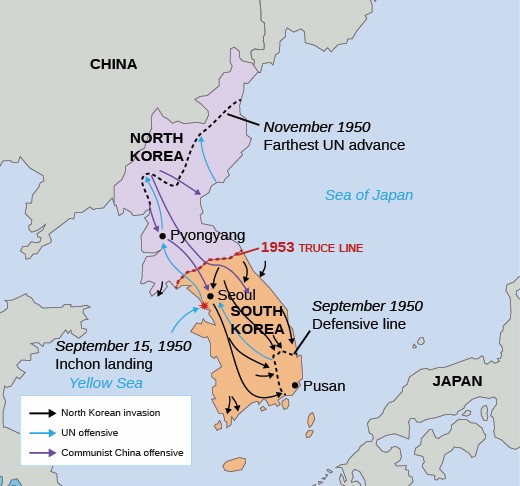
After the initial invasion of South Korea by the North Korean People’s Democratic Army, the United Nations established a defensive line in the southern part of the country. The landing at Inchon in September reversed the tide of the war and allowed UN forces under General Douglas MacArthur to retake the city of Seoul, which had fallen to North Korean troops in the early days of the war. Source: Wikimedia Commons
An armistice agreement was signed on July 27, 1953. A border between North and South Korea, one quite close to the original thirty-eighth parallel line, was agreed upon. A demilitarized zone between the two nations was established, and both sides agreed that prisoners of war would be allowed to choose whether to be returned to their homelands. Five million people died in the three-year conflict. Of these, around 36,500 were U.S. soldiers; a majority were Korean civilians.
CONTAINMENT AT HOME
As the war in Korea came to an end, so did one of the most frightening anti-Communist campaigns in the United States. After charging the U.S. State Department with harboring Communists, Senator Joseph McCarthy made similar accusations against other government agencies. In 1953, as chair of the Senate Committee on Government Operations, McCarthy investigated the Voice of America, which broadcast news and pro-U.S. propaganda to foreign countries, and the State Department’s overseas libraries. After an aborted effort to investigate Protestant clergy, McCarthy turned his attention to the U.S. Army. From April to June 1954, the Army-McCarthy Hearings were televised, and the American public, able to witness his use of intimidation and innuendo firsthand, rejected McCarthy’s approach to rooting out Communism in the United States. In December 1954, the U.S. Senate officially condemned his actions with a censure, ending his prospects for political leadership.
One particularly heinous aspect of the hunt for Communists in the United States, likened by playwright Arthur Miller to the witch hunts of old, was its effort to root out gay men and lesbians employed by the government. Many anti-Communists, including McCarthy, believed that gay men, referred to by Senator Everett Dirksen as “lavender lads,” were morally weak and thus were particularly likely to betray their country. Many also believed that lesbians and gay men were prone to being blackmailed by Soviet agents because of their sexual orientation, which at the time was regarded by psychiatrists as a form of mental illness.
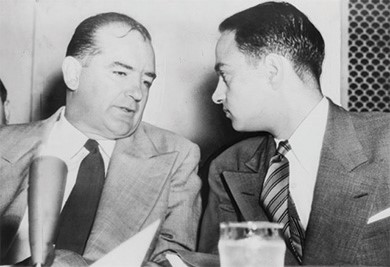
Senator Joseph McCarthy (left) consults with Roy Cohn (right) during the Army-McCarthy hearings. Cohn, a lawyer who worked for McCarthy, was responsible for investigating State Department libraries overseas for “subversive” books. Source: Wikimedia Commons
12.2 Section Summary
Joy at the ending of World War II was quickly replaced by fears of conflict with the Soviet Union. The Cold War heated up as both the United States and Soviet Union struggled for world dominance. Fearing Soviet expansion, the United States committed itself to assisting countries whose governments faced overthrow by Communist forces and gave billions of dollars to war-torn Europe to help it rebuild. While the United States achieved victory in its thwarting of Soviet attempts to cut Berlin off from the West, the nation was less successful in its attempts to prevent Communist expansion in Korea. The development of atomic weapons by the Soviet Union and the arrest of Soviet spies in the United States and Britain roused fears in the United States that Communist agents were seeking to destroy the nation from within. Loyalty board investigations and hearings before House and Senate committees attempted to root out Soviet sympathizers in the federal government and in other sectors of American society, including Hollywood and the military.
12.3 The American Dream
Learning Objectives
By the end of this section, you will be able to:
- Describe President Dwight D. Eisenhower’s domestic and foreign policies
- Discuss gender roles in the 1950s
- Discuss the growth of the suburbs and the effect of suburbanization on American society
Against the backdrop of the Cold War, Americans dedicated themselves to building a peaceful and prosperous society after the deprivation and instability of the Great Depression and World War II. Dwight D. Eisenhower, the general who led the United States to victory in Europe in 1945, proved to be the perfect president for the new era. Lacking strong conservative positions, he steered a middle path between conservatism and liberalism, and presided over a peacetime decade of economic growth and social conformity. In foreign affairs, Eisenhower’s New Look policy simultaneously expanded the nation’s nuclear arsenal and prevented the expansion of the defense budget for conventional forces.
WE LIKE IKE
After Harry Truman declined to run again for the presidency, the election of 1952 emerged as a contest between the Democratic nominee, Illinois governor Adlai Stevenson, and Republican Dwight D. Eisenhower, who had directed American forces in Europe during World War II. He was the perfect presidential candidate in 1952. He had never before run for office or even cast a vote, and thus had no political record to be challenged or criticized. In 1952, Eisenhower supporters enthusiastically proclaimed, “We Like Ike,” and Eisenhower defeated Stevenson by winning 54 percent of the popular vote and 87 percent of the electoral vote. Stevenson carried only the South, where whites had voted for Democratic Party candidates since the time of the Civil War.
In keeping with his goal of a balanced budget, Eisenhower switched the emphasis in defense from larger conventional forces to greater stockpiles of nuclear weapons. His New Look strategy embraced nuclear “massive retaliation,” a plan for nuclear response to a first Soviet strike so devastating that the attackers would not be able to respond. Some labeled this approach “Mutually Assured Destruction” or MAD. Part of preparing for a possible war with the Soviet Union was informing the American public what to do in the event of a nuclear attack. The government provided instructions for building and equipping bomb shelters in the basement or backyard, and some cities constructed municipal shelters. Schools purchased dog tags to help identify students in the aftermath of an attack and showed children instructional films telling them what to do if atomic bombs were dropped on the city where they lived.
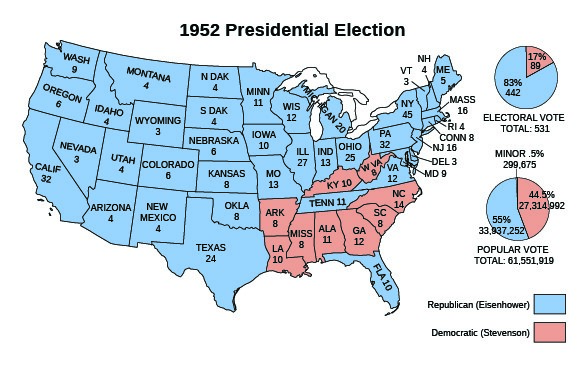
|
|
AMERICANA |
|
“A Guide for Surviving Nuclear War” To prepare its citizens for the possibility of nuclear war, in 1950, the U.S. government published and distributed informative pamphlets such as “A Guide for Surviving Nuclear War” excerpted here. Just like fire bombs and ordinary high explosives, atomic weapons cause most of their death and damage by blast and heat. So first let’s look at a few things you can do to escape these two dangers. Even if you have only a second’s warning, there is one important thing you can do to lessen your chances of injury by blast: Fall flat on your face. More than half of all wounds are the result of being bodily tossed about or being struck by falling and flying objects. If you lie down flat, you are least likely to be thrown about. If you have time to pick a good spot, there is less chance of your being struck by flying glass and other things. If you are inside a building, the best place to flatten out is close against the cellar wall. If you haven’t time to get down there, lie down along an inside wall, or duck under a bed or table. . . If caught out-of-doors, either drop down alongside the base of a good substantial building—avoid flimsy, wooden ones likely to be blown over on top of you—or else jump in any handy ditch or gutter. When you fall flat to protect yourself from a bombing, don’t look up to see what is coming. Even during the daylight hours, the flash from a bursting A-bomb can cause several moments of blindness, if you’re facing that way. To prevent it, bury your face in your arms and hold it there for 10 to 12 seconds after the explosion. . . . |
|
Government and industry allocated enormous amounts of money to the research and development of more powerful weapons. This investment generated rapid strides in missile technology as well as increasingly sensitive radar. Computers that could react more quickly than humans and thereby shoot down speeding missiles were also investigated. However, the United States often feared that the Soviets were making greater strides in developing technology with potential military applications.
This was especially true following the Soviet Union’s launch of Sputnik, the first manmade satellite, in October 1957. In September 1958, Congress passed the National Defense Education Act, which pumped over $775 million into educational programs over four years, especially those programs that focused on math and science. Congressional appropriations to the National Science Foundation also increased by $100 million in a single year, from $34 million in 1958 to $134 million in 1959. One consequence of this increased funding was the growth of science and engineering programs at American universities.
In the diplomatic sphere, Eisenhower pushed Secretary of State John Foster Dulles to take a firmer stance against the Soviets to reassure European allies of continued American support. At the same time, keenly sensing that the stalemate in Korea had cost Truman his popularity, Eisenhower worked to avoid being drawn into foreign wars. Thus, when the French found themselves fighting Vietnamese Communists for control of France’s former colony of Indochina, Eisenhower provided money but not troops. Likewise, the United States took no steps when Hungary attempted to break away from Soviet domination in 1956. The United States also refused to be drawn in when Great Britain, France, and Israel invaded the Suez Canal Zone following Egypt’s nationalization of the canal in 1956. Indeed, Eisenhower, wishing to avoid conflict with the Soviet Union, threatened to impose economic sanctions on the invading countries if they did not withdraw.
SUBURBANIZATION
Although the Eisenhower years were marked by fear of the Soviet Union and its military might, they were also a time of peace and prosperity for many. Wishing to build the secure life that the Great Depression had deprived their parents of, young men and women married in record numbers and purchased homes where they could start families of their own. In 1940, the rate of homeownership in the United States was 43.6 percent. By 1960, it was almost 62 percent. Many of these newly purchased homes had been built in the new suburban areas that began to encircle American cities after the war. Although middle-class families had begun to move to the suburbs beginning in the nineteenth century, suburban growth accelerated rapidly after World War II.
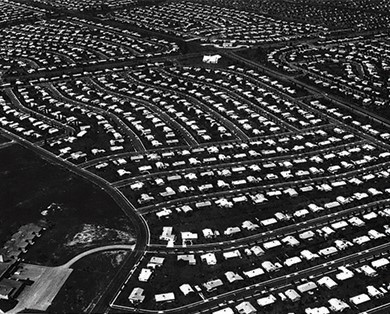
This aerial view of Levittown, Pennsylvania, reveals acres of standardized homes. The roads were curved to prevent cars from speeding through the residential community that was home to many young families. Source: Wikimedia Commons
In the decade between 1950 and 1960, the suburbs grew by 46 percent. The development of the suburbs increased reliance on the automobile for transportation. In the early years of suburban development, before schools, parks, and supermarkets were built, access to an automobile was crucial, and the pressure on families to purchase a second one was strong. As families rushed to purchase them, the annual production of passenger cars leaped from 2.2 million to 8 million between 1946 and 1955, and by 1960, about 20 percent of suburban families owned two cars. The growing number of cars on the road changed consumption patterns, and drive-in and drive-through convenience stores, restaurants, and movie theaters began to dot the landscape. The first McDonalds opened in San Bernardino, California, in 1954 to cater to drivers in a hurry.
As drivers jammed highways and small streets in record numbers, cities and states rushed to build additional roadways and ease congestion. To help finance these massive construction efforts, states began taxing gasoline, and the federal government provided hundreds of thousands of dollars for the construction of the interstate highway system. The resulting construction projects, designed to make it easier for suburbanites to commute to and from cities, often destroyed urban working-class neighborhoods. Increased funding for highway construction also left less money for public transportation, making it impossible for those who could not afford automobiles to live in the suburbs.
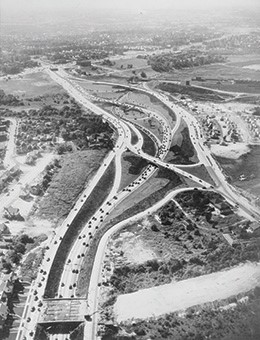
In the late 1940s, a network of newly constructed highways connected suburban Long Island with Manhattan. The nation’s new road network also served a military purpose; interstate highways made it easier to deploy troops in the event of a national emergency. Source: Wikimedia Commons
CONFORMITY
As the government poured money into the defense industry and into universities that conducted research for the government, the economy boomed. The construction and automobile industries employed thousands, as did the industries they relied upon: steel, oil and gasoline refining, rubber, and lumber. As people moved into new homes, their purchases of appliances, carpeting, furniture, and home decorations spurred growth in other industries. The building of miles of roads also employed thousands. Unemployment was low, and wages for members of both the working and middle classes were high.
Following World War II, the majority of white Americans were members of the middle class, based on such criteria as education, income, and home ownership. Even most blue-collar families could afford such elements of a middle-class lifestyle as new cars, suburban homes, and regular vacations. Most African Americans, however, were not members of the middle class. In 1950, the median income for white families was $20,656, whereas for black families it was $11,203. By 1960, when the average white family earned $28,485 a year, blacks still lagged behind at $15,786; nevertheless, this represented a more than 40 percent increase in African American income in the space of a decade.
While working-class men found jobs in factories and on construction crews, those in the middle class often worked for corporations that, as a result of government spending, had grown substantially during World War II and were still getting larger. Such corporations, far too large to allow managers to form personal relationships with all of their subordinates, valued conformity to company rules and standards above all else.
Conformity was the watchword of suburban life: Many neighborhoods had rules mandating what types of clotheslines could be used and prohibited residents from parking their cars on the street. Above all, conforming to societal norms meant marrying young and having children. In the post-World War II period, marriage rates rose; the average age at first marriage dropped to twenty-three for men and twenty for women. Between 1946 and 1964, married couples also gave birth to the largest generation in U.S. history to date; this baby boom resulted in the cohort known as the baby boomers.
Conformity also required that the wives of both working- and middle-class men stay home and raise children instead of working for wages outside the home. Most conformed to this norm, at least while their children were young. Nevertheless, 40 percent of women with young children and half of women with older children sought at least part-time employment. They did so partly out of necessity and partly to pay for the new elements of “the good life”—second cars, vacations, and college education for their children.
The children born during the baby boom were members of a more privileged generation than their parents had been. Entire industries sprang up to cater to their need for clothing, toys, games, books, and breakfast cereals. For the first time in U.S. history, attending high school was an experience shared by the majority, regardless of race or region. As the baby boomers grew into adolescence, marketers realized that they not only controlled large amounts of disposable income earned at part-time jobs, but they exerted a great deal of influence over their parents’ purchases as well. Madison Avenue began to appeal to teenage interests. Boys yearned for cars, and girls of all ethnicities wanted boyfriends who had them. New fashion magazines for adolescent girls, such as Seventeen, advertised the latest clothing and cosmetics, and teen romance magazines, like Copper Romance, a publication for young African American women, filled drugstore racks. The music and movie industries also altered their products to appeal to affluent adolescents who were growing tired of parental constraints.
12.3 Section Summary
In 1953, Dwight D. Eisenhower became president of the United States. Fiscally conservative but ideologically moderate, he sought to balance the budget while building a strong system of national defense. This defense policy led to a greater emphasis on the possible use of nuclear weapons in any confrontation with the Soviet Union. Committed to maintaining peace, however, Eisenhower avoided engaging the United States in foreign conflicts; during his presidency, the economy boomed. Young Americans married in record numbers, moved to the growing suburbs, and gave birth to the largest generation to date in U.S. history. As middle-class adults, they conformed to the requirements of corporate jobs and suburban life, while their privileged children enjoyed a consumer culture tailored to their desires.
12.4 Popular Culture and Mass Media
Learning Objectives
By the end of this section, you will be able to:
- Describe Americans’ different responses to rock and roll music
- Discuss the way contemporary movies and television reflected postwar American society
With a greater generational consciousness than previous generations, the baby boomers sought to define and redefine their identities in numerous ways. Music, especially rock and roll, reflected their desire to rebel against adult authority. Other forms of popular culture, such as movies and television, sought to entertain, while reinforcing values such as religious faith, patriotism, and conformity to societal norms.
ROCKING AROUND THE CLOCK
In the late 1940s, some white country musicians began to experiment with the rhythms of the blues, a decades-old musical genre of rural southern blacks. This experimentation led to the creation of a new musical form known as rockabilly, and by the 1950s, rockabilly had developed into rock and roll. Rock and roll music celebrated themes such as young love and freedom from the oppression of middle-class society. The theme of rebellion against authority, present in many rock and roll songs, appealed to teens. In 1954, Bill Haley and His Comets provided youth with an anthem for their rebellion—”Rock Around the Clock.” The song, used in the 1955 movie Blackboard Jungle about a white teacher at a troubled inner-city high school, seemed to be calling for teens to declare their independence from adult control.
Haley illustrated how white artists could take musical motifs from the African American community and achieve mainstream success. Teen heartthrob Elvis Presley rose to stardom doing the same. Thus, besides encouraging a feeling of youthful rebellion, rock and roll also began to tear down color barriers, as white youths sought out African American musicians such as Chuck Berry and Little Richard.
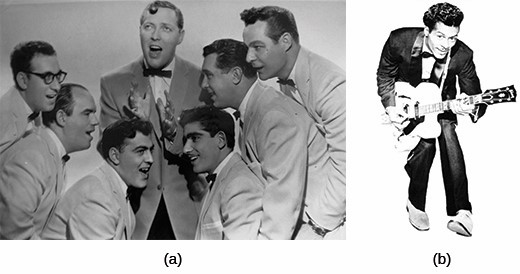
The band Bill Haley and His Comets (a) was among the first to launch the new genre of rock and roll. Their hit song “Rock Around the Clock” supposedly caused some teens to break into violent behavior when they heard it. Chuck Berry (b) was a performer who combined rhythm and blues and rock and roll. He dazzled crowds with guitar solos and electrifying performances. Source: Wikimedia Commons
HOLLYWOOD ON THE DEFENSIVE
At first, Hollywood encountered difficulties in adjusting to the post-World War II environment. Although domestic audiences reached a record high in 1946 and the war’s end meant expanding international markets too, the groundwork for the eventual dismantling of the traditional studio system was laid in 1948, with a landmark decision by the U.S. Supreme Court. Previously, film studios had owned their own movie theater chains in which they exhibited the films they produced; however, in United States v. Paramount Pictures, Inc., this vertical integration of the industry—the complete control by one firm of the production, distribution, and exhibition of motion pictures—was deemed a violation of antitrust laws.
The House Committee on Un-American Activities (HUAC), which had been established in 1938 to investigate suspected Nazi sympathizers, after World War II sought to root out suspected Communists in business, academia, and the media. HUAC was particularly interested in Hollywood because it feared that Communist sympathizers might use motion pictures as pro-Soviet propaganda. Witnesses were subpoenaed and required to testify before the committee; refusal could result in imprisonment. Those who invoked Fifth Amendment protections, or were otherwise suspected of Communist sympathies, often lost their jobs or found themselves on a blacklist, which prevented them from securing employment. Notable artists who were blacklisted in the 1940s and 1950s include composer Leonard Bernstein, novelist Dashiell Hammett, playwright and screenwriter Lillian Hellman, actor and singer Paul Robeson, and musician Artie Shaw.
Hollywood reacted aggressively to these various challenges. Filmmakers tried new techniques, like CinemaScope and Cinerama, which allowed movies to be shown on large screens and in 3-D. Audiences were drawn to movies not because of gimmicks, however, but because of the stories they told. Dramas and romantic comedies continued to be popular fare for adults, and, to appeal to teens, studios produced large numbers of horror films and movies starring music idols such as Elvis. Many films took espionage, a timely topic, as their subject matter, and science fiction hits such as Invasion of the Body Snatchers, about a small town whose inhabitants fall prey to space aliens, played on audience fears of both Communist invasion and nuclear technology.
THE TRIUMPH OF TELEVISION
By far the greatest challenge to Hollywood, however, came from the relatively new medium of television. Although the technology had been developed in the late 1920s, through much of the 1940s, only a fairly small audience of the wealthy had access to it. As a result, programming was limited. With the post-World War II economic boom, all this changed. Where there had been only 178,000 televisions in homes in 1948, by 1955, over three-quarters of a million U.S. households, about half of all homes, had television.
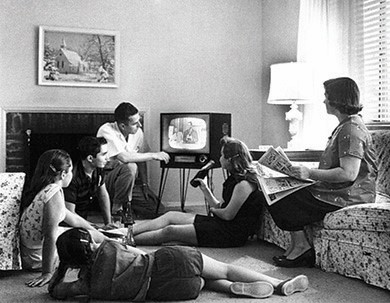
An American family relaxes in front of their television set in 1958. Many gathered not only to watch the programming but also to eat dinner. The marketing of small folding tray tables and frozen “TV dinners” encouraged such behavior. Source: Wikimedia Commons
Various types of programs were broadcast on the handful of major networks: situation comedies, variety programs, game shows, soap operas, talk shows, medical dramas, adventure series, cartoons, and police procedurals. Many comedies presented an idealized image of white suburban family life: Happy housewife mothers, wise fathers, and mischievous but not dangerously rebellious children were constants on shows like Leave It to Beaver and Father Knows Best in the late 1950s. These shows also reinforced certain perspectives on the values of individualism and family—values that came to be redefined as “American” in opposition to alleged Communist collectivism. Westerns, which stressed unity in the face of danger and the ability to survive in hostile environments, were popular too. Programming for children began to emerge with shows such as Captain Kangaroo, Romper Room, and The Mickey Mouse Club designed to appeal to members of the baby boom.
12.4 Section Summary
Young Americans in the postwar period had more disposable income and enjoyed greater material comfort than their forebears. These factors allowed them to devote more time and money to leisure activities and the consumption of popular culture. Rock and roll, which drew from African American roots in the blues, embraced themes popular among teenagers, such as young love and rebellion against authority. At the same time, traditional forms of entertainment, such as motion pictures, came under increasing competition from a relatively new technology, television.
12.5 The African American Struggle for Civil Rights
Learning Objectives
By the end of this section, you will be able to:
- Explain how Presidents Truman and Eisenhower addressed civil rights issues
- Discuss efforts by African Americans to end discrimination and segregation
- Describe southern whites’ response to the civil rights movement
In the aftermath of World War II, African Americans began to mount organized resistance to racially discriminatory policies in force throughout much of the United States. In the South, they used a combination of legal challenges and grassroots activism to begin dismantling the racial segregation that had stood for nearly a century following the end of Reconstruction. Community activists and civil rights leaders targeted racially discriminatory housing practices, segregated transportation, and legal requirements that African Americans and whites be educated separately. While many of these challenges were successful, life did not necessarily improve for African Americans. Hostile whites fought these changes in any way they could, including by resorting to violence.
EARLY VICTORIES
During World War II, many African Americans had supported the “Double V Campaign,” which called on them to defeat foreign enemies while simultaneously fighting against segregation and discrimination at home. After World War II ended, many returned home to discover that, despite their sacrifices, the United States was not willing to extend them any greater rights than they had enjoyed before the war. Particularly rankling was the fact that although African American veterans were legally entitled to draw benefits under the GI Bill, discriminatory practices prevented them from doing so. For example, many banks would not give them mortgages if they wished to buy homes in predominantly African American neighborhoods, which banks often considered too risky an investment. However, African Americans who attempted to purchase homes in white neighborhoods often found themselves unable to do so because of real estate covenants that prevented owners from selling their property to blacks.
The postwar era, however, saw African Americans make greater use of the courts to defend their rights. In 1944, an African American woman, Irene Morgan, was arrested in Virginia for refusing to give up her seat on an interstate bus and sued to have her conviction overturned. In Morgan v. the Commonwealth of Virginia in 1946, the U.S. Supreme Court ruled that the conviction should be overturned because it violated the interstate commerce clause of the Constitution. Other victories followed. In 1948, in Shelley v. Kraemer, the U.S. Supreme Court held that courts could not enforce real estate covenants that restricted the purchase or sale of property based on race. In 1950, the NAACP brought a case before the U.S. Supreme Court that they hoped would help to undermine the concept of “separate but equal” as espoused in the 1896 decision in Plessy v. Ferguson, which gave legal sanction to segregated school systems. Sweatt v. Painter was a case brought by Herman Marion Sweatt, who sued the University of Texas for denying him admission to its law school because state law prohibited integrated education. Texas attempted to form a separate law school for African Americans only, but in its decision on the case, the U.S. Supreme Court rejected this solution, holding that the separate school provided neither equal facilities nor “intangibles,” such as the ability to form relationships with other future lawyers, that a professional school should provide.
Not all efforts to enact desegregation required the use of the courts, however. On April 15, 1947, Jackie Robinson started for the Brooklyn Dodgers, playing first base. He was the first African American to play baseball in the National League, breaking the color barrier. Other African American athletes also began to challenge the segregation of American sports. At the 1948 Summer Olympics, Alice Coachman, an African American, was the only American woman to take a gold medal in the games. These changes, while symbolically significant, were mere cracks in the wall of segregation.
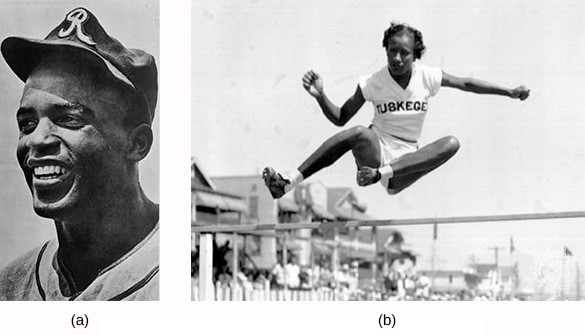
Baseball legend Jackie Robinson (a) was active in the civil rights movement. He served on the NAACP’s board of directors and helped to found an African American-owned bank. Alice Coachman (b), who competed in track and field at Tuskegee University, was the first black woman to win an Olympic gold medal. Source: Wikimedia Commons
DESEGREGATION AND INTEGRATION
Until 1954, racial segregation in education was not only legal but was required in seventeen states and permissible in several others. Utilizing evidence provided in sociological studies conducted by Kenneth Clark and Gunnar Myrdal, however, Thurgood Marshall, then chief counsel for the NAACP, successfully argued the landmark case Brown v. Board of Education of Topeka, Kansas before the U.S. Supreme Court led by Chief Justice Earl Warren. Marshall showed that the practice of segregation in public schools made African American students feel inferior. Even if the facilities provided were equal in nature, the Court noted in its decision, the very fact that some students were separated from others on the basis of their race made segregation unconstitutional. Plessy v. Fergusson had been overturned. The challenge now was to integrate schools. A year later, the U.S. Supreme Court ordered southern school systems to begin desegregation “with all deliberate speed.” Some school districts voluntarily integrated their schools. For many other districts, however, “deliberate speed” was very, very slow.

This map shows those states in which racial segregation in public education was required by law before the 1954 Brown v. Board of Education decision. In 1960, four years later, fewer than 10 percent of southern African American students attended the same schools as white students. Source: Wikimedia Commons
It soon became clear that enforcing Brown v. the Board of Education would require presidential intervention. In 1957, Central High School in Little Rock, Arkansas, was forced to accept its first nine African American students, who became known as the Little Rock Nine. Eisenhower placed the Arkansas National Guard under federal control and sent the U.S. Army’s 101st airborne unit to escort the students to and from school as well as from class to class. This was the first time since the end of Reconstruction that federal troops once more protected the rights of African Americans in the South. Throughout the course of the school year, the Little Rock Nine were insulted, harassed, and physically assaulted; nevertheless, they returned to school each day. At the end of the school year, the first African American student graduated from Central High. At the beginning of the 1958–1959 school year, Orval Faubus ordered all Little Rock’s public schools closed. In the opinion of white segregationists, keeping all students out of school was preferable to having them attend integrated schools. In 1959, the U.S. Supreme Court ruled that the school had to be reopened and that the process of desegregation had to proceed.
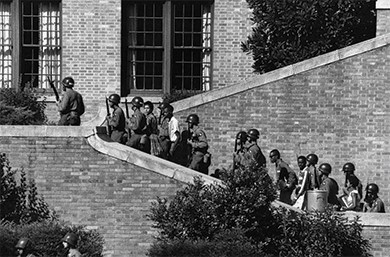
In 1957, U.S. soldiers from the 101st Airborne were called in to escort the Little Rock Nine into and around formerly all-white Central High School in Little Rock, Arkansas. Source: Wikimedia Commons
|
|
DEFINING “AMERICAN” |
|
Thurgood Marshall on Fighting Racism By 1938, Thurgood Marshall had become “Mr. Civil Rights” and formally organized the NAACP’s Legal Defense and Education Fund in 1940 to garner the resources to take on cases to break the racist justice system of America. A direct result of Marshall’s energies and commitment was his 1940 victory in a Supreme Court case, Chambers v. Florida, which held that confessions obtained by violence and torture were inadmissible in a court of law. His most well-known case was Brown v. Board of Education in 1954, which held that state laws establishing separate public schools for black and white students were unconstitutional. Later in life, Marshall reflected on his career fighting racism in a speech at Howard Law School in 1978: Be aware of that myth, that everything is going to be all right. Don’t give in. I add that, because it seems to me, that what we need to do today is to refocus. Back in the 30s and 40s, we could go no place but to court. We knew then, the court was not the final solution. Many of us knew the final solution would have to be politics, if for no other reason, politics is cheaper than lawsuits. So now we have both. We have our legal arm, and we have our political arm. Let’s use them both. And don’t listen to this myth that it can be solved by either or that it has already been solved. Take it from me, it has not been solved.
In 1956, NAACP leaders (from left to right) Henry L. Moon, Roy Wilkins, Herbert Hill, and Thurgood Marshall present a new poster in the campaign against southern white racism. Marshall successfully argued the landmark case Brown v. Board of Education (1954) before the U.S. Supreme Court and later became the court’s first African American justice. Source: Wikimedia Commons
|
|
WHITE RESPONSES
Efforts to desegregate public schools led to a backlash among most southern whites. Many greeted the Brown decision with horror. Some white parents promptly withdrew their children from public schools and enrolled them in all-white private academies, many newly created for the sole purpose of keeping white children from attending integrated schools.
Some southern school districts responded by closing all public schools. One county in Virginia closed its public schools for five years rather than see them integrated. Many national politicians supported the segregationist efforts. In 1956, ninety-six members of Congress signed “The Southern Manifesto,” in which they accused the U.S. Supreme Court of misusing its power and violating the principle of states’ rights, which maintained that states had rights equal to those of the federal government.
Unfortunately, many white southern racists, frightened by challenges to the social order, responded with violence. White rage sometimes erupted into murder. In August 1955, both white and black Americans were shocked by the brutality of the murder of Emmett Till. Till, a fourteen-year-old boy from Chicago, had been vacationing with relatives in Mississippi. While visiting a white-owned store, he had made a remark to the white woman behind the counter. A few days later, the husband and brother-in-law of the woman came to the home of Till’s relatives in the middle of the night and abducted the boy. Till’s beaten and mutilated body was found in a nearby river three days later. Till’s mother insisted on an open-casket funeral; she wished to use her son’s body to reveal the brutality of southern racism. The murder of a child who had been guilty of no more than a casual remark captured the nation’s attention, as did the acquittal of the two men who admitted killing him.
THE MONTGOMERY BUS BOYCOTT
One of those inspired by Till’s death was Rosa Parks, an NAACP member from Montgomery, Alabama, who became the face of the 1955–1956 Montgomery Bus Boycott. City ordinances in Montgomery segregated the city’s buses, forcing African American passengers to ride in the back section. They had to enter through the rear of the bus, could not share seats with white passengers, and, if the front of the bus was full and a white passenger requested an African American’s seat, had to relinquish their place to the white rider. The bus company also refused to hire African American drivers even though most of the people who rode the buses were black.
On December 1, 1955, Rosa Parks refused to give her seat to a white man, and the Montgomery police arrested her. After being bailed out of jail, she decided to fight the laws requiring segregation in court. To support her, the Women’s Political Council, a group of African American female activists, organized a boycott of Montgomery’s buses. News of the boycott spread through newspaper notices and by word of mouth; ministers rallied their congregations to support the Women’s Political Council. Their efforts were successful, and forty thousand African American riders did not take the bus on December 5, the first day of the boycott.
Other African American leaders within the city embraced the boycott and maintained it beyond December 5, Rosa Parks’ court date. Among them was a young minister named Martin Luther King, Jr. For the next year, black Montgomery residents avoided the city’s buses. Some organized carpools. Others paid for rides in African American-owned taxis, whose drivers reduced their fees. Most walked to and from school, work, and church for 381 days, the duration of the boycott. In June 1956, an Alabama federal court found the segregation ordinance unconstitutional. The city appealed, but the U.S. Supreme Court upheld the decision. The city’s buses were desegregated.
12.5 Section Summary
After World War II, African American efforts to secure greater civil rights increased across the United States. African American lawyers such as Thurgood Marshall championed cases intended to destroy the Jim Crow system of segregation that had dominated the American South since Reconstruction. The landmark Supreme Court case Brown v. Board of Education prohibited segregation in public schools, but not all school districts integrated willingly, and President Eisenhower had to use the military to desegregate Little Rock’s Central High School. The courts and the federal government did not assist African Americans in asserting their rights in other cases. In Montgomery, Alabama, it was the grassroots efforts of African American citizens who boycotted the city’s bus system that brought about change. Throughout the region, many white southerners made their opposition to these efforts known. Too often, this opposition manifested itself in violence and tragedy, as in the murder of Emmett Till.
12.6 The Kennedy Promise
Learning Objectives
By the end of this section, you will be able to:
- Assess Kennedy’s Cold War strategy
- Describe Kennedy’s contribution to the civil rights movement
In the 1950s, President Dwight D. Eisenhower presided over a United States that prized conformity over change. Although change naturally occurred, as it does in every era, it was slow and greeted warily. By the 1960s, however, the pace of change had quickened, and its scope broadened, as restive and energetic waves of World War II veterans and baby boomers of both sexes and all ethnicities began to make their influence felt politically, economically, and culturally. No one symbolized the hopes and energies of the new decade more than John Fitzgerald Kennedy, the nation’s new, young, and seemingly healthful, president. Kennedy had emphasized the country’s aspirations and challenges as a “new frontier” when accepting his party’s nomination at the Democratic National Convention in Los Angeles, California.
Kennedy’s popular reputation as a great politician undoubtedly owes much to the style and attitude he personified. He and his wife Jacqueline conveyed a sense of optimism and youthfulness. “Jackie” was an elegant first lady who wore designer dresses, served French food in the White House, and invited classical musicians to entertain at state functions. “Jack” Kennedy, or JFK, went sailing off the coast of his family’s Cape Cod estate and socialized with celebrities. Few knew that behind Kennedy’s healthful and sporty image was a gravely ill man whose wartime injuries caused him daily agony.
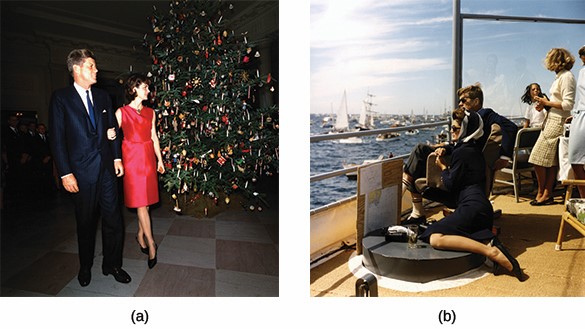
John F. Kennedy and first lady Jacqueline, shown here in the White House in 1962 (a) and watching the America’s Cup race that same year (b), brought youth, glamour, and optimism to Washington, DC, and the nation. Source: Wikimedia Commons
Kennedy did not appeal to all voters, however. Many feared that because he was Roman Catholic, his decisions would be influenced by the Pope. Even traditional Democratic supporters, like the head of the United Auto Workers, Walter Reuther, feared that a Catholic candidate would lose the support of Protestants. Many southern Democrats also disliked Kennedy because of his liberal position on civil rights. To shore up support for Kennedy in the South, Lyndon B. Johnson, the Protestant Texan who was Senate majority leader, was added to the Democratic ticket as the vice-presidential candidate. In the end, Kennedy won the election by the closest margin since 1888, defeating Nixon with only 0.01 percent more of the record sixty-seven million votes cast. His victory in the Electoral College was greater: 303 electoral votes to Nixon’s 219. Kennedy’s win made him both the youngest man elected to the presidency and the first U.S. president born in the twentieth century.
Kennedy dedicated his inaugural address to the theme of a new future for the United States. “Ask not what your country can do for you; ask what you can do for your country,” he challenged his fellow Americans. His lofty goals ranged from fighting poverty to winning the space race against the Soviet Union with a moon landing. He assembled an administration of energetic people assured of their ability to shape the future. Dean Rusk was named secretary of state. Robert McNamara, the former president of Ford Motor Company, became secretary of defense. Kennedy appointed his younger brother Robert as attorney general, much to the chagrin of many who viewed the appointment as a blatant example of nepotism.
Kennedy’s domestic reform plans remained hampered, however, by his narrow victory and lack of support from members of his own party, especially southern Democrats. As a result, he remained hesitant to propose new civil rights legislation. His achievements came primarily in poverty relief and care for the disabled. Unemployment benefits were expanded, the food stamps program was piloted, and the school lunch program was extended to more students. In October 1963, the passage of the Mental Retardation Facilities and Community Mental Health Centers Construction Act increased support for public mental health services.
KENNEDY THE COLD WARRIOR
Kennedy focused most of his energies on foreign policy. For example, in response to the lead that the Soviets had taken in the space race when Yuri Gagarin became the first human to successfully orbit the earth, Kennedy urged Congress to not only put a man into space but also land an American on the moon, a goal finally accomplished in 1969. To counter Soviet influence in the developing world, Kennedy supported a variety of measures. One of these was the Alliance for Progress, which collaborated with the governments of Latin American countries to promote economic growth and social stability in nations whose populations might find themselves drawn to communism.
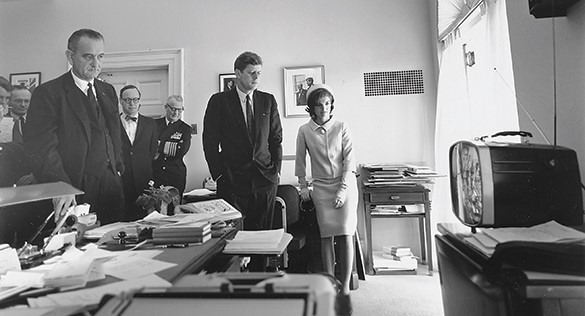
On May 5, 1961, Alan Shepard became the first American to travel into space, as millions across the country watched the television coverage of his mission, including Vice President Johnson, President Kennedy, and Jacqueline Kennedy in the White House. Source: Wikimedia Commons
Kennedy also established the Agency for International Development to oversee the distribution of foreign aid, and he founded the Peace Corps, which recruited idealistic young people to undertake humanitarian projects in Asia, Africa, and Latin America. Kennedy’s various aid projects, like the Peace Corps, fit closely with his administration’s flexible response, which Robert McNamara advocated as a better alternative to the all-or-nothing defensive strategy of mutually assured destruction favored during Eisenhower’s presidency. The plan was to develop different strategies, tactics, and even military capabilities to respond more appropriately to small or medium-sized insurgencies, and political or diplomatic crises.
Cuba
Kennedy’s multifaceted approach to national defense is exemplified by his careful handling of the Communist government of Fidel Castro in Cuba. In January 1959, following the overthrow of the corrupt and dictatorial regime of Fulgencio Batista, Castro assumed leadership of the new Cuban government. The progressive reforms he began indicated that he favored Communism, and his pro-Soviet foreign policy frightened the Eisenhower administration, which asked the Central Intelligence Agency (CIA) to find a way to remove him from power. Rather than have the U.S. military invade the small island nation, less than one hundred miles from Florida, and risk the world’s criticism, the CIA instead trained a small force of Cuban exiles for the job. After landing at the Bay of Pigs on the Cuban coast, these insurgents, the CIA believed, would inspire their countrymen to rise up and topple Castro’s regime.
Kennedy agreed to support the previous administration’s plans, and on April 17, 1961, approximately fourteen hundred Cuban exiles stormed ashore at the designated spot. However, the poorly trained volunteers were easily defeated by the Cuban army. The hoped-for uprising of the Cuban people failed to occur. The surviving members of the exile army were taken into custody. The Bay of Pigs invasion was a major foreign policy disaster for President Kennedy. The event highlighted how difficult it would be for the United States to act against the Castro administration. The following year, the Soviet Union sent troops and technicians to Cuba to strengthen its new ally against further U.S. military plots. Then, on October 14, U.S. spy planes took aerial photographs that confirmed the presence of long-range ballistic missile sites in Cuba. The United States was now within easy reach of Soviet nuclear warheads.
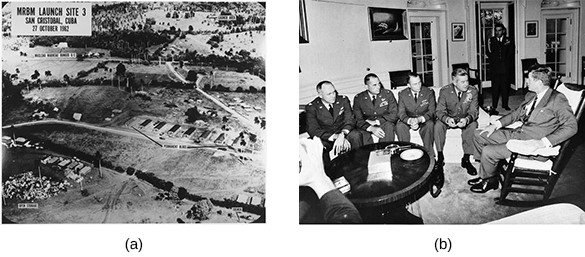
This low-level U.S. Navy photograph of San Cristobal, Cuba, clearly shows one of the sites built to launch intermediate-range missiles at the United States (a). As the date indicates, it was taken on the last day of the Cuban Missile Crisis. Following the crisis, Kennedy met with the reconnaissance pilots who flew the Cuban missions Source: Wikimedia Commons
On October 22, Kennedy demanded that Soviet premier Nikita Khrushchev remove the missiles. He also ordered a naval quarantine placed around Cuba to prevent Soviet ships from approaching. As U.S. ships headed for Cuba, the army was told to prepare for war, and Kennedy appeared on national television to declare his intention to defend the Western Hemisphere from Soviet aggression.
The world held its breath awaiting the Soviet reply. Realizing how serious the United States was, Khrushchev sought a peaceful solution to the crisis, overruling those in his government who urged a harder stance. Behind the scenes, Robert Kennedy and Soviet ambassador Anatoly Dobrynin worked toward a compromise that would allow both superpowers to back down without either side’s seeming intimidated by the other. On October 26, Khrushchev agreed to remove the Russian missiles in exchange for Kennedy’s promise to remove its warheads which were in Turkey, as close to Soviet targets as the Cuban missiles had been to American ones. On October 27, Kennedy’s agreement was made public, and the crisis ended.
The showdown between the United States and the Soviet Union over Cuba’s missiles had put the world on the brink of a nuclear war. Both sides already had long-range bombers with nuclear weapons airborne or ready for launch and were only hours away from the first strike. In the long run, this nearly catastrophic example of nuclear brinksmanship ended up making the world safer. A telephone “hot line” was installed, linking Washington and Moscow to avert future crises, and in 1963, Kennedy and Khrushchev signed the Limited Test Ban Treaty, prohibiting tests of nuclear weapons in Earth’s atmosphere.
TENTATIVE STEPS TOWARD CIVIL RIGHTS
Cold War concerns, which guided U.S. foreign policy, also motivated the Kennedy administration’s steps toward racial equality. Realizing that legal segregation and widespread discrimination hurt the country’s chances of gaining allies in Africa, Asia, and Latin America, the federal government increased efforts to secure the civil rights of African Americans in the 1960s. Lacking widespread backing in Congress, however, and anxious not to offend white southerners, Kennedy was cautious in assisting African Americans in their fight for full citizenship rights.
His strongest focus was on securing the voting rights of African Americans. Encouraged by Congress’s passage of the Civil Rights Act of 1960, which permitted federal courts to appoint referees to guarantee that qualified persons would be registered to vote, Kennedy focused on the passage of a constitutional amendment outlawing poll taxes, a tactic that southern states used to disenfranchise African American voters. It passed both houses of Congress and was sent to the states for ratification in September 1962.
Kennedy also reacted to the demands of the civil rights movement for equality in education. For example, when African American student James Meredith, encouraged by Kennedy’s speeches, attempted to enroll at the segregated University of Mississippi in 1962, riots broke out on campus. The president responded by sending the U.S. Army and National Guard to Oxford, Mississippi, to support the U.S. Marshals that his brother Robert, the attorney general, had dispatched.
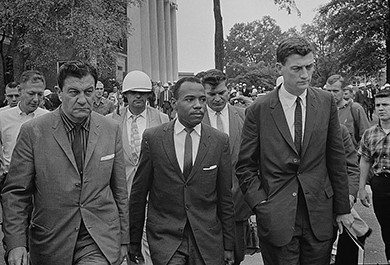
Escorted by a U.S. marshal and the assistant attorney general for civil rights, James Meredith (center) enters the University of Mississippi over the riotous protests of white southerners. Meredith later attempted a “March against Fear” in 1966 to protest the inability of southern African Americans to vote. His walk ended when a passing motorist shot and wounded him. Source: Wikimedia Commons
TRAGEDY IN DALLAS
Although his stance on civil rights had won him support in the African American community and his steely performance during the Cuban Missile Crisis had led his overall popularity to surge, Kennedy understood that he had to solidify his base in the South to secure his reelection in 1964. On November 21, 1963, he accompanied Lyndon Johnson to Texas to rally his supporters. The next day, shots rang out as Kennedy’s motorcade made its way through the streets of Dallas. Seriously injured, Kennedy was rushed to Parkland Hospital and pronounced dead.
The gunfire that killed Kennedy appeared to come from the upper stories of the Texas School Book Depository building; later that day, Lee Harvey Oswald, an employee at the depository and a trained sniper, was arrested. Two days later, while being transferred from Dallas police headquarters to the county jail, Oswald was shot and killed by Jack Ruby, a local nightclub owner who claimed he acted to avenge the president.
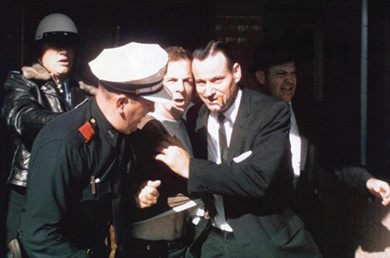
Lee Harvey Oswald (center) was arrested at the Texas Theatre in Dallas a few hours after shooting President Kennedy. Source: Wikimedia Commons
12.6 Section Summary
The arrival of the Kennedys in the White House seemed to signal a new age of youth, optimism, and confidence. Kennedy spoke of a “new frontier” and promoted the expansion of programs to aid the poor, protect African Americans’ right to vote, and improve African Americans’ employment and education opportunities. For the most part, however, Kennedy focused on foreign policy and countering the threat of Communism—especially in Cuba, where he successfully defused the Cuban Missile Crisis, and in Vietnam, to which he sent advisors and troops to support the South Vietnamese government. The tragedy of Kennedy’s assassination in Dallas brought an early end to the era, leaving Americans to wonder whether his vice president and successor, Lyndon Johnson, would bring Kennedy’s vision for the nation to fruition.
12.7 Lyndon Johnson and the Great Society
Learning Objectives
By the end of this section, you will be able to:
- Describe the major accomplishments of Lyndon Johnson’s Great Society
- Identify the legal advances made in the area of civil rights
- Explain how Lyndon Johnson deepened the American commitment in Vietnam
On November 27, 1963, a few days after taking the oath of office, President Johnson addressed a joint session of Congress and vowed to accomplish the goals that John F. Kennedy had set and to expand the role of the federal government in securing economic opportunity and civil rights for all. Johnson brought to his presidency a vision of a Great Society in which everyone could share in the opportunities for a better life that the United States offered, and in which the words “liberty and justice for all” would have real meaning.
THE GREAT SOCIETY
When the Eighty-Ninth Congress convened the following January, Johnson and his supporters began their effort to turn his vision into reality. By combatting racial discrimination and attempting to eliminate poverty, the reforms of the Johnson administration changed the nation. One of the chief pieces of legislation that Congress passed in 1965 was the Elementary and Secondary Education Act. Johnson, a former teacher, realized that a lack of education was the primary cause of poverty and other social problems. Educational reform was thus an important pillar of the society he hoped to build. This act provided increased federal funding to both elementary and secondary schools, allocating more than $1 billion for the purchase of books and library materials, and the creation of educational programs for disadvantaged children.
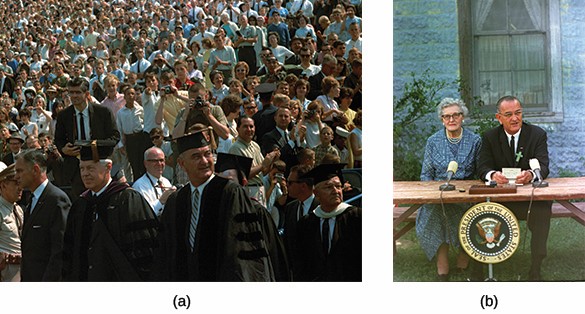
In a speech at the University of Michigan in Ann Arbor on May 22, 1964 (a), President Johnson announced some of his goals for the Great Society. These included rebuilding cities, preserving the natural environment, and improving education. Johnson signed the Elementary and Secondary Education Act in his hometown of Johnson City, Texas, alongside his childhood schoolteacher, Kate Deadrich Loney (b). Source: Wikimedia Commons
Education was not the only area toward which Johnson directed his attention. Consumer protection laws were also passed that improved the safety of meat and poultry, placed warning labels on cigarette packages, required “truth in lending” by creditors, and set safety standards for motor vehicles. Funds were provided to improve public transportation and to fund high-speed mass transit. To protect the environment, the Johnson administration created laws protecting air and water quality, regulating the disposal of solid waste, preserving wilderness areas, and protecting endangered species. All of these laws fit within Johnson’s plan to make the United States a better place to live.
In 1965, the Johnson administration also encouraged Congress to pass the Immigration and Nationality Act, which essentially overturned legislation from the 1920s that had favored immigrants from western and northern Europe over those from eastern and southern Europe. The law lifted severe restrictions on immigration from Asia and gave preference to immigrants with family ties in the United States and immigrants with desirable skills. Although the measure seemed less significant than many of the other legislative victories of the Johnson administration at the time, it opened the door for a new era in immigration and made possible the formation of Asian and Latin American immigrant communities in the following decades.
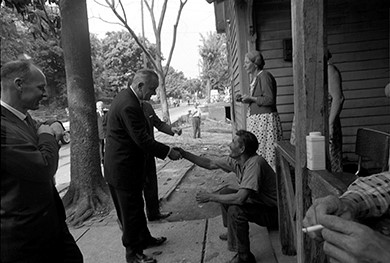
President Johnson visits a poor family in Appalachia in 1964. Government initiatives designed to combat poverty helped rural communities like this one by providing low-interest loans and housing. Source: Wikimedia Commons
While these laws touched on important aspects of the Great Society, the centerpiece of Johnson’s plan was the eradication of poverty in the United States. The war on poverty, as he termed it, was fought on many fronts. The 1965 Housing and Urban Development Act offered grants to improve city housing and subsidized rents for the poor. The Model Cities program likewise provided money for urban development projects and the building of public housing. The Economic Opportunity Act (EOA) of 1964 established and funded a variety of programs to assist the poor in finding jobs. Volunteers in Service to America recruited people to offer educational programs and other community services in poor areas, just as the Peace Corps did abroad. The Community Action Program, also under the OEO, funded local Community Action Agencies, organizations created and managed by residents of disadvantaged communities to improve their own lives and those of their neighbors.
The Johnson administration, realizing the nation’s elderly were among its poorest and most disadvantaged citizens, passed the Social Security Act of 1965. The most profound change made by this act was the creation of Medicare, a program to pay the medical expenses of those over sixty-five. The following year, the Medicaid program allotted federal funds to pay for medical care for the poor.
JOHNSON’S COMMITMENT TO CIVIL RIGHTS
The eradication of poverty was matched in importance by the Great Society’s advancement of civil rights. Indeed, the condition of the poor could not be alleviated if racial discrimination limited their access to jobs, education, and housing. Realizing this, Johnson drove the long-awaited civil rights act, proposed by Kennedy in June 1963. The Civil Rights Act of 1964, the most far-reaching civil rights act yet passed by Congress, banned discrimination in public accommodations, sought to aid schools in efforts to desegregate, and prohibited federal funding of programs that permitted racial segregation. Further, it barred discrimination in employment on the basis of race, color, national origin, religion, or gender, and established an Equal Employment Opportunity Commission.
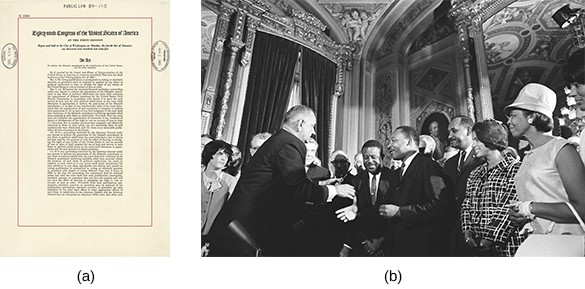
The Voting Rights Act (a) was signed into law on August 6, 1965, in the presence of major figures of the civil rights movement, including Rosa Parks and Martin Luther King, Jr. (b). Source: Wikimedia Commons
Protecting African Americans’ right to vote was as important as ending racial inequality in the United States. In January 1964, the Twenty-Fourth Amendment, prohibiting the imposition of poll taxes on voters, was finally ratified. Poverty would no longer serve as an obstacle to voting. Other impediments remained, however. Attempts to register southern African American voters encountered white resistance, and protests against this interference often met with violence. On March 7, 1965, a planned protest march from Selma, Alabama, to the state capitol in Montgomery, turned into “Bloody Sunday” when marchers crossing the Edmund Pettus Bridge encountered a cordon of state police, wielding batons and tear gas. Images of white brutality appeared on television screens throughout the nation and in newspapers around the world.
Deeply disturbed by the violence in Alabama and the refusal of Governor George Wallace to address it, Johnson introduced a bill in Congress that would remove obstacles for African American voters and lend federal support to their cause. His proposal, the Voting Rights Act of 1965, prohibited states and local governments from passing laws that discriminated against voters on the basis of race. Literacy tests and other barriers to voting that had kept ethnic minorities from the polls were thus outlawed. Following the passage of the act, a quarter of a million African Americans registered to vote, and by 1967, the majority of African Americans had done so. Johnson’s final piece of civil rights legislation was the Civil Rights Act of 1968, which prohibited discrimination in housing on the basis of race, color, national origin, or religion.
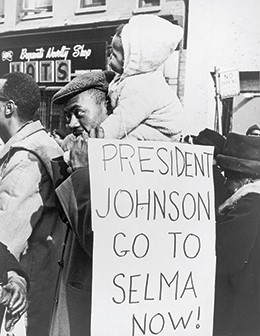
African American marchers in Selma, Alabama, were attacked by state police officers in 1965, and the resulting “Bloody Sunday” helped create support for the civil rights movement among northern whites. Source: Wikimedia Commons
COMMITMENT IN VIETNAM
Building the Great Society had been Lyndon Johnson’s biggest priority, and he effectively used his decades of experience in building legislative majorities in a style that ranged from diplomacy to quid pro quo deals to bullying. In the summer of 1964, he deployed these political skills to secure congressional approval for a new strategy in Vietnam—with fateful consequences. US involvement in Vietnam had begun in 1950, the Truman administration sent a small military advisory group to Vietnam. In the chaos that followed World War II, the Vietnamese successfully overthrew the French who had colonized their country. Internal rivalries then divided the country into a southern pro-Western region and a northern pro-Communist region. The United States, fearing the spread of Communism under the political leader of the North, Ho Chi Minh, supported the leader of the South, Ngo Dinh Diem, in the belief that he would create a democratic, pro-Western government in South Vietnam. When Kennedy took office, Diem’s government was faltering. Continuing the policies of the Eisenhower administration, Kennedy supplied Diem with money and military advisors to prop up his government. By November 1963, with Kennedy’s approval, there were sixteen thousand U.S. troops in Vietnam, training members of that country’s special forces and flying air missions that dumped defoliant chemicals on the countryside to expose North Vietnamese and NLF forces and supply routes.
President Johnson had never been the cold warrior Kennedy was but believed that the credibility of the nation and his office depended on maintaining a foreign policy of containment. When, on August 2, the U.S. destroyer USS Maddox conducted an arguably provocative intelligence-gathering mission in the gulf of Tonkin in Vietnam, it reported an attack by North Vietnamese torpedo boats. Two days later, the Maddox was supposedly struck again, and a second ship, the USS Turner Joy, reported that it also had been fired upon. Relying on information available at the time, however, Secretary of Defense Robert McNamara reported to Congress that U.S. ships had been fired upon in international waters while conducting routine operations. On August 7, with only two dissenting votes, Congress passed the Gulf of Tonkin Resolution, and on August 10, the president signed the resolution into law. The resolution gave President Johnson the authority to use military force in Vietnam without asking Congress for a declaration of war.
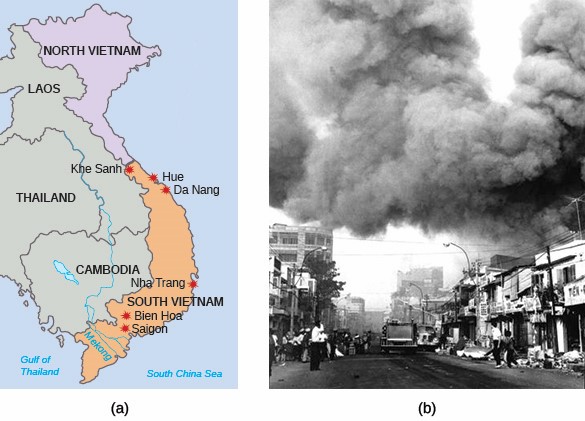
During the 1968 Tet Offensive, North Vietnamese and South Communist rebel armies known as Viet Cong attacked South Vietnamese and U.S. targets throughout Vietnam (a), with Saigon as the focus (b). Tet, the lunar New Year, was an important holiday in Vietnam and temporary ceasefires usually took place at this time. Source: Wikimedia Commons
In 1965, large-scale U.S. bombing of North Vietnam began. More than 200,000 U.S. military personnel, including combat troops, were sent to South Vietnam. At first, most of the American public supported the president’s actions in Vietnam. Support began to ebb, however, as more troops were deployed. By April 1966, more Americans were being killed in battle than North Vietnamese troops. Johnson, however, maintained that the war could be won if the United States stayed the course. However, this pronouncement was called into question, when in January 1968, the North Vietnamese launched their most aggressive assault on the South, deploying close to eighty-five thousand troops. During the Tet Offensive, as these attacks were known, nearly one hundred cities in the South were attacked, including the capital of Saigon. Although, in heavy fighting, U.S. and South Vietnamese forces recaptured all the points taken by the enemy, the Tet Offensive persuaded many that the war would not be over soon and raised doubts about whether Johnson’s administration was telling the truth about the real state of affairs. In May 1968, with over 400,000 U.S. soldiers in Vietnam, bowing to public pressure, Johnson began peace talks with the North.
It was too late to save Johnson himself, however. Many of the most outspoken critics of the war were Democratic politicians whose opposition began to erode unity within the party. Minnesota senator Eugene McCarthy, who had called for an end to the war and the withdrawal of troops from Vietnam, received nearly as many votes in the New Hampshire presidential primary as Johnson did, even though he had been expected to fare very poorly. McCarthy’s success in New Hampshire encouraged Robert Kennedy to announce his candidacy as well. Johnson, suffering health problems and realizing his actions in Vietnam had hurt his public standing, announced that he would not seek reelection and withdrew from the 1968 presidential race.
THE END OF THE GREAT SOCIETY
Perhaps the greatest casualty of the nation’s war in Vietnam was the Great Society. As the war escalated, the money spent to fund it also increased, leaving less to pay for the many social programs Johnson had created to lift Americans out of poverty. Johnson knew he could not achieve his Great Society while spending money to wage the war. He was unwilling to withdraw from Vietnam, however, for fear that the world would perceive this action as evidence of American failure and doubt the ability of the United States to carry out its responsibilities as a superpower.
Vietnam doomed the Great Society in other ways as well. Dreams of racial harmony suffered, as many African Americans, angered by the failure of Johnson’s programs to alleviate severe poverty in the inner cities, rioted in frustration. Their anger was heightened by the fact that a disproportionate number of African Americans were fighting and dying in Vietnam. Nearly two-thirds of eligible African Americans were drafted, whereas draft deferments for college, exemptions for skilled workers in the military industrial complex, and officer training programs allowed white middle-class youth to either avoid the draft or volunteer for a military branch of their choice. As a result, less than one-third of white men were drafted.
12.7 Section Summary
Lyndon Johnson began his administration with dreams of fulfilling his fallen predecessor’s civil rights initiative and accomplishing his own plans to improve lives by eradicating poverty in the United States. His social programs, investments in education, support for the arts, and commitment to civil rights changed the lives of countless people and transformed society in many ways. However, Johnson’s insistence on maintaining American commitments in Vietnam, a policy begun by his predecessors, hurt both his ability to realize his vision of the Great Society and his support among the American people.
12.8 The Civil Rights Movement Marches On
Learning Objectives
By the end of this section, you will be able to:
- Explain the strategies of the African American civil rights movement in the 1960s
- Discuss the rise and philosophy of Black Power
- Identify achievements of the Mexican American civil rights movement in the 1960s
During the 1960s, the federal government, encouraged by both genuine concern for the dispossessed and the realities of the Cold War, had increased its efforts to protect civil rights and ensure equal economic and educational opportunities for all. However, most of the credit for progress toward racial equality in the Unites States lies with grassroots activists. Indeed, it was campaigns and demonstrations by ordinary people that spurred the federal government to action. Although the African American civil rights movement was the most prominent of the crusades for racial justice, other ethnic minorities also worked to seize their piece of the American dream during the promising years of the 1960s. Many were influenced by the African American cause and often used similar tactics.
CHANGE FROM THE BOTTOM UP
For many people inspired by the victories of Brown v. Board of Education and the Montgomery Bus Boycott, the glacial pace of progress in the segregated South was frustrating if not intolerable. Martin Luther King Jr.’s inspirational appeal for peaceful change in the city of Greensboro in 1958 planted the seed for a more assertive civil rights movement.
On February 1, 1960, four sophomores at the North Carolina Agricultural & Technical College in Greensboro—Ezell Blair, Jr., Joseph McNeil, David Richmond, and Franklin McCain—entered the local Woolworth’s and sat at the lunch counter. The lunch counter was segregated, and they were refused service as they knew they would be. They had specifically chosen Woolworth’s, because it was a national chain and was thus believed to be especially vulnerable to negative publicity. Over the next few days, more protesters joined the four sophomores. Hostile whites responded with threats and taunted the students by pouring sugar and ketchup on their heads. The successful six-month-long Greensboro sit-in initiated the student phase of the African American civil rights movement, and, within two months, the sit-in movement had spread to fifty-four cities in nine states.

Businesses such as this one were among those that became targets of activists protesting segregation. Segregated businesses could be found throughout the United States; this one was located in Ohio. Source: Wikimedia Commons
In the words of grassroots civil rights activist Ella Baker, the students at Woolworth’s wanted more than a hamburger; the movement they helped launch was about empowerment. Baker pushed for a “participatory Democracy” that built on the grassroots campaigns of active citizens instead of deferring to the leadership of educated elites and experts. As a result of her actions, in April 1960, the Student Nonviolent Coordinating Committee (SNCC) formed to carry the battle forward. Within a year, more than one hundred cities had desegregated at least some public accommodations in response to student led demonstrations. The sit-ins inspired other forms of nonviolent protest intended to desegregate public spaces. “Sleep-ins” occupied motel lobbies, “read-ins” filled public libraries, and churches became the sites of “pray-ins.” Students also took part in the 1961 “freedom rides” sponsored by the Congress of Racial Equality (CORE) and SNCC. Whites would ride in the back, African Americans would sit in the front, and on other occasions, riders of different races would share the same bench seat. The intent of the African American and white volunteers who undertook these bus rides south was to test enforcement of a U.S. Supreme Court decision prohibiting segregation on interstate transportation and to protest segregated waiting rooms in southern terminals.
Students also took part in the 1961 “freedom rides” sponsored by the Congress of Racial Equality (CORE) and SNCC. The intent of the African American and white volunteers who undertook these bus rides south was to test enforcement of a U.S. Supreme Court decision prohibiting segregation on interstate transportation and to protest segregated waiting rooms in southern terminals. Departing Washington, DC, on May 4, the volunteers headed south on buses that challenged the seating order of Jim Crow segregation. Whites would ride in the back, African Americans would sit in the front, and on other occasions, riders of different races would share the same bench seat. The freedom riders encountered little difficulty until they reached Rock Hill, South Carolina, where a mob severely beat John Lewis, a freedom rider who later became chairman of SNCC. The danger increased as the riders continued through Georgia into Alabama, where one of the two buses was firebombed outside the town of Anniston. The second group continued to Birmingham, where the riders were attacked by the Ku Klux Klan as they attempted to disembark at the city bus station. The remaining volunteers continued to Mississippi, where they were arrested when they attempted to desegregate the waiting rooms in the Jackson bus terminal.
FREE BY ’63 (OR ’64 OR ’65)
The grassroots efforts of people like the Freedom Riders to change discriminatory laws and longstanding racist traditions grew more widely known in the mid-1960s. The approaching centennial of Abraham Lincoln’s Emancipation Proclamation spawned the slogan “Free by ’63” among civil rights activists. As African Americans increased their calls for full rights for all Americans, many civil rights groups changed their tactics to reflect this new urgency.
Perhaps the most famous of the civil rights-era demonstrations was the March on Washington for Jobs and Freedom, held in August 1963, on the one hundredth anniversary of Abraham Lincoln’s Emancipation Proclamation. Its purpose was to pressure President Kennedy to act on his promises regarding civil rights. The date was the eighth anniversary of the brutal racist murder of fourteen-year-old Emmett Till in Money, Mississippi. As the crowd gathered outside the Lincoln Memorial and spilled across the National Mall, Martin Luther King, Jr. delivered his most famous speech. In “I Have a Dream,” King called for an end to racial injustice in the United States and envisioned a harmonious, integrated society. The speech marked the high point of the civil rights movement and established the legitimacy of its goals.
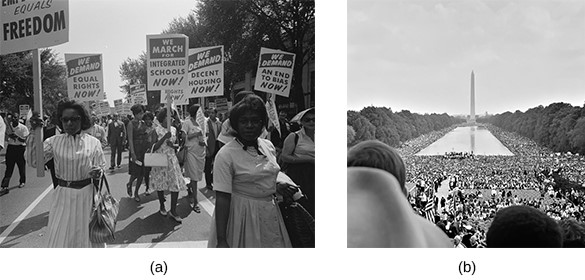
During the March on Washington for Jobs and Freedom (a), a huge crowd gathered on the National Mall (b) to hear the speakers. Although thousands attended, many of the march’s organizers had hoped that enough people would come to Washington to shut down the city. Source: Wikimedia Commons
In 1963, the Southern Christian Leadership Conference (SCLC) led by Martin Luther King, Jr. mounted protests in some 186 cities throughout the South. The campaign in Birmingham that began in April and extended into the fall of 1963 attracted the most notice, however, when a peaceful protest was met with violence by police, who attacked demonstrators, including children, with fire hoses and dogs. The world looked on in horror as innocent people were assaulted and thousands arrested. King himself was jailed on Easter Sunday, 1963, and, in response to the pleas of white clergymen for peace and patience, he penned one of the most significant documents of the struggle—“Letter from a Birmingham Jail.” In the letter, King argued that African Americans had waited patiently for more than three hundred years to be given the rights that all human beings deserved; the time for waiting was over.
When Dr. Martin Luther King Jr. wrote Letter from Birmingham Jail in April 1963, he was responding to criticism from local white clergy who had called his civil rights activism “unwise and untimely.” Writing from a jail cell, King offered one of the most powerful and enduring defenses of nonviolent resistance ever produced. His letter has become a foundational text in the history of American protest, justice, and moral philosophy.
As you listen, consider the following: How does King justify civil disobedience? What does he say about the difference between just and unjust laws? How does he appeal to American founding principles, religious traditions, and historical examples? What role does time—waiting, urgency, delay—play in his argument? And how does King balance respect for law with a call to break certain laws?
Listen to Dr. King read Letter from Birmingham Jail here.
Some of the greatest violence during this era was aimed at those who attempted to register African Americans to vote. In 1964, SNCC, working with other civil rights groups, initiated its Mississippi Summer Project, also known as Freedom Summer. The purpose was to register African American voters in one of the most racist states in the nation. Volunteers also built “freedom schools” and community centers. SNCC invited hundreds of white middle-class students, mostly from the North, to help in the task. Many volunteers were harassed, beaten, and arrested, and African American homes and churches were burned. Three civil rights workers, James Chaney, Michael Schwerner, and Andrew Goodman, were killed by the Ku Klux Klan. That summer, civil rights activists Fannie Lou Hamer, Ella Baker, and Robert Parris Moses formally organized the Mississippi Freedom Democratic Party (MFDP) as an alternative to the all-white Mississippi Democratic Party. The Democratic National Convention’s organizers, however, would allow only two MFDP delegates to be seated, and they were confined to the roles of nonvoting observers.
|
|
DEFINING “AMERICAN” |
|
Letter from a Birmingham Jail While the campaign in Birmingham began with an African American boycott of white businesses to end discrimination in employment practices and public segregation, it became a fight over free speech when King was arrested for violating a local injunction against demonstrations. Martin Luther King, Jr. wrote his “Letter from a Birmingham Jail” in response to an op-ed by eight white Alabama clergymen who complained about the SCLC’s fiery tactics and argued that social change needed to be pursued gradually. The letter criticizes those who did not support the cause of civil rights: In spite of my shattered dreams of the past, I came to Birmingham with the hope that the white religious leadership in the community would see the justice of our cause and, with deep moral concern, serve as the channel through which our just grievances could get to the power structure. I had hoped that each of you would understand. But again I have been disappointed. I have heard numerous religious leaders of the South call upon their worshippers to comply with a desegregation decision because it is the law, but I have longed to hear white ministers say follow this decree because integration is morally right and the Negro is your brother. In the midst of blatant injustices inflicted upon the Negro, I have watched white churches stand on the sideline and merely mouth pious irrelevancies and sanctimonious trivialities. In the midst of a mighty struggle to rid our nation of racial and economic injustice, I have heard so many ministers say, “Those are social issues with which the Gospel has no real concern,” and I have watched so many churches commit themselves to a completely other-worldly religion which made a strange distinction between body and soul, the sacred and the secular. Since its publication, the “Letter” has become one of the most cogent, impassioned, and succinct statements of the aspirations of the civil rights movement and the frustration over the glacial pace of progress in achieving justice and equality for all Americans. |
|
The vision of whites and African Americans working together peacefully to end racial injustice suffered a severe blow with the death of Martin Luther King, Jr. in Memphis, Tennessee, in April 1968. King had gone there to support sanitation workers trying to unionize. In the city, he found a divided civil rights movement; older activists who supported his policy of nonviolence were being challenged by younger African Americans who advocated a more militant approach. On April 4, King was shot and killed while standing on the balcony of his motel. Within hours, the nation’s cities exploded with violence as angry African Americans, shocked by his murder, burned and looted inner-city neighborhoods across the country. While whites recoiled from news about the riots in fear and dismay, they also criticized African Americans for destroying their own neighborhoods; they did not realize that most of the violence was directed against businesses that were not owned by blacks and that treated African American customers with suspicion and hostility.
BLACK FRUSTRATION, BLACK POWER
The episodes of violence that accompanied Martin Luther King Jr.’s murder were but the latest in a string of urban riots that had shaken the United States since the mid-1960s. Between 1964 and 1968, there were 329 riots in 257 cities across the nation. In 1964, riots broke out in Harlem and other African American neighborhoods. In 1965, a traffic stop set in motion a chain of events that culminated in riots in Watts, an African American neighborhood in Los Angeles. Thousands of businesses were destroyed, and, by the time the violence ended, thirty-four people were dead, most of them African Americans killed by the Los Angeles police and the National Guard. More riots took place in 1966 and 1967.
Frustration and anger lay at the heart of these disruptions. Despite the programs of the Great Society, good healthcare, job opportunities, and safe housing were abysmally lacking in urban African American neighborhoods in cities throughout the country, including in the North and West, where discrimination was less overt but just as crippling. In the eyes of many rioters, the federal government either could not or would not end their suffering, and most existing civil rights groups and their leaders had been unable to achieve significant results toward racial justice and equality. Disillusioned, many African Americans turned to those with more radical ideas about how best to obtain equality and justice.
Within the chorus of voices calling for integration and legal equality were many that more stridently demanded empowerment and thus supported Black Power. Black Power meant a variety of things. One of the most famous users of the term was Stokely Carmichael, the chairman of SNCC. For Carmichael, Black Power was the power of African Americans to unite as a political force and create their own institutions apart from white-dominated one. Carmichael became an advocate of black separatism, arguing that African Americans should live apart from whites and solve their problems for themselves.
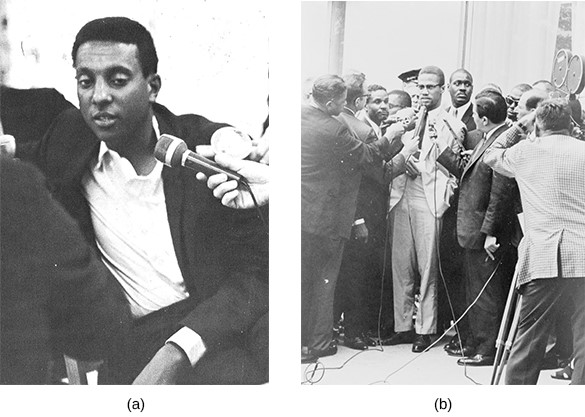
Stokely Carmichael (a), one of the most famous and outspoken advocates of Black Power, is surrounded by members of the media after speaking at Michigan State University in 1967. Malcolm X (b) was raised in a family influenced by Marcus Garvey and persecuted for its outspoken support of civil rights. While serving a stint in prison for armed robbery, he was introduced to and committed himself to the Nation of Islam. Source: Wikimedia Commons
|
|
DEFINING “AMERICAN” |
|
The New Negro In a roundtable conversation in October 1961, Malcolm X suggested that a “New Negro” was coming to the fore. The term and concept of a “New Negro” arose during the Harlem Renaissance of the 1920s and was revived during the civil rights movements of the 1960s. “I think there is a new so-called Negro. We don’t recognize the term ‘Negro’ but I really believe that there’s a new so-called Negro here in America. He not only is impatient. Not only is he dissatisfied, not only is he disillusioned, but he’s getting very angry. And whereas the so-called Negro in the past was willing to sit around and wait for someone else to change his condition or correct his condition, there’s a growing tendency on the part of a vast number of so-called Negroes today to take action themselves, not to sit and wait for someone else to correct the situation. This, in my opinion, is primarily what has produced this new Negro. He is not willing to wait. He thinks that what he wants is right, what he wants is just, and since these things are just and right, it’s wrong to sit around and wait for someone else to correct a nasty condition when they get ready.” |
|
Long before Carmichael began to call for separatism, the Nation of Islam, founded in 1930, had advocated the same thing. In the 1960s, its most famous member was Malcolm X, born Malcolm Little The Nation of Islam advocated the separation of white Americans and African Americans because of a belief that African Americans could not thrive in an atmosphere of white racism. In 1964, after a trip to Africa, Malcolm X left the Nation of Islam to found the Organization of Afro-American Unity with the goal of achieving freedom, justice, and equality “by any means necessary.” His views regarding black-white relations changed somewhat thereafter, but he remained fiercely committed to the cause of African American empowerment. On February 21, 1965, he was killed by members of the Nation of Islam. Stokely Carmichael later recalled that Malcolm X had provided an intellectual basis for Black Nationalism and given legitimacy to the use of violence in achieving the goals of Black Power.
The self-empowerment philosophy of Black Power influenced mainstream civil rights groups such as the National Economic Growth Reconstruction Organization (NEGRO), which sold bonds and operated a clothing factory and construction company in New York, and the Opportunities Industrialization Center in Philadelphia, which provided job training and placement—by 1969, it had branches in seventy cities. Black Power was also part of a much larger process of cultural change. The 1960s composed a decade not only of Black Power but also of Black Pride. African American abolitionist John S. Rock had coined the phrase “Black Is Beautiful” in 1858, but in the 1960s, it became an important part of efforts within the African American community to raise self-esteem and encourage pride in African ancestry. Black Pride urged African Americans to reclaim their African heritage and, to promote group solidarity, to substitute African and African-inspired cultural practices, such as handshakes, hairstyles, and dress, for white practices. One of the many cultural products of this movement was the popular television music program Soul Train, created by Don Cornelius in 1969, which celebrated black culture and aesthetics.

When the Jackson Five appeared on Soul Train, each of the five brothers sported a large afro, a symbol of Black Pride in the 1960s and 70s. Source: Wikimedia Commons
THE MEXICAN AMERICAN FIGHT FOR CIVIL RIGHTS
The African American bid for full citizenship was surely the most visible of the battles for civil rights taking place in the United States. However, other minority groups that had been legally discriminated against or otherwise denied access to economic and educational opportunities began to increase efforts to secure their rights in the 1960s. Like the African American movement, the Mexican American civil rights movement won its earliest victories in the federal courts. In 1947, in Mendez v. Westminster, the U.S. Court of Appeals for the Ninth Circuit ruled that segregating children of Hispanic descent was unconstitutional. In 1954, the same year as Brown v. Board of Education, Mexican Americans prevailed in Hernandez v. Texas, when the U.S. Supreme Court extended the protections of the Fourteenth Amendment to all ethnic groups in the United States.
The highest-profile struggle of the Mexican American civil rights movement was the fight that Caesar Chavez and Dolores Huerta waged in the fields of California to organize migrant farm workers. In 1962, Chavez and Huerta founded the National Farm Workers Association (NFWA). In 1965, when Filipino grape pickers led by Filipino American Larry Itliong went on strike to call attention to their plight, Chavez lent his support. Workers organized by the NFWA also went on strike, and the two organizations merged to form the United Farm Workers. When Chavez asked American consumers to boycott grapes, politically conscious people around the country heeded his call, and many unionized longshoremen refused to unload grape shipments. In 1966, Chavez led striking workers to the state capitol in Sacramento, further publicizing the cause. Martin Luther King, Jr. telegraphed words of encouragement to Chavez, whom he called a “brother.” The strike ended in 1970 when California farmers recognized the right of farm workers to unionize. However, the farm workers did not gain all they sought, and the larger struggle did not end.
The equivalent of the Black Power movement among Mexican Americans was the Chicano Movement. Proudly adopting a derogatory term for Mexican Americans, Chicano activists demanded increased political power for Mexican Americans, education that recognized their cultural heritage, and the restoration of lands taken from them at the end of the Mexican American War in 1848. One of the founding members, Rodolfo “Corky” Gonzales, launched the Crusade for Justice in Denver in 1965, to provide jobs, legal services, and healthcare for Mexican Americans. From this movement arose La Raza Unida, a political party that attracted many Mexican American college students. Elsewhere, Reies López Tijerina fought for years to reclaim lost and illegally expropriated ancestral lands in New Mexico; he was one of the cosponsors of the Poor People’s March on Washington in 1967.
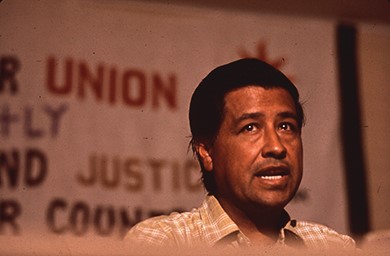
Cesar Chavez was influenced by the nonviolent philosophy of Indian nationalist Mahatma Gandhi. In 1968, he emulated Gandhi by engaging in a hunger strike. Source: Wikimedia Commons
12.8 Section Summary
The African American civil rights movement made significant progress in the 1960s. While Congress played a role by passing the Civil Rights Act of 1964, the Voting Rights Act of 1965, and the Civil Rights Act of 1968, the actions of civil rights groups such as CORE, the SCLC, and SNCC were instrumental in forging new paths, pioneering new techniques and strategies, and achieving breakthrough successes. Civil rights activists engaged in sit-ins, freedom rides, and protest marches, and registered African American voters. Despite the movement’s many achievements, however, many grew frustrated with the slow pace of change, the failure of the Great Society to alleviate poverty, and the persistence of violence against African Americans, particularly the tragic 1968 assassination of Martin Luther King, Jr. Many African Americans in the mid- to late 1960s adopted the ideology of Black Power, which promoted their work within their own communities to redress problems without the aid of whites. The Mexican American civil rights movement, led largely by Cesar Chavez, also made significant progress at this time. The emergence of the Chicano Movement signaled Mexican Americans’ determination to seize their political power, celebrate their cultural heritage, and demand their citizenship rights.
12.9 Challenging the Status Quo
Learning Objectives
By the end of this section, you will be able to:
- Describe the goals and activities of SDS, the Free Speech Movement, and the antiwar movement
- Explain the rise, goals, and activities of the women’s movement
By the 1960s, a generation of white Americans raised in prosperity and steeped in the culture of conformity of the 1950s had come of age. However, many of these baby boomers (those born between 1946 and 1964) rejected the conformity and luxuries that their parents had provided. These young, middle-class Americans, especially those fortunate enough to attend college when many of their working-class and African American contemporaries were being sent to Vietnam, began to organize to fight for their own rights and end the war that was claiming the lives of so many.
THE NEW LEFT
By 1960, about one-third of the U.S. population was living in the suburbs; during the 1960s, the average family income rose by 33 percent. Material culture blossomed, and at the end of the decade, 70 percent of American families owned washing machines, 83 percent had refrigerators or freezers, and almost 80 percent had at least one car. Entertainment occupied a larger part of both working- and middle-class leisure hours. By 1960, American consumers were spending $85 billion a year on entertainment, double the spending of the preceding decade; by 1969, about 79 percent of American households had black-and-white televisions, and 31 percent could afford color sets. Movies and sports were regular aspects of the weekly routine, and the family vacation became an annual custom for both the middle and working class.
|
|
AMERICANA |
|
Blue Jeans: The Uniform of Nonconformist Radicalism Overwhelmingly, young cultural warriors and social activists of the 1960s, trying to escape the shackles of what they perceived to be limits on their freedoms, adopted blue jeans as the uniform of their generation. Originally worn by manual laborers because of their near-indestructibility, blue jeans were commonly associated with cowboys, the quintessential icon of American independence. During the 1930s, jeans were adopted by a broader customer base as a result of the popularity of cowboy movies and dude ranch vacations. After World War II, Levi Strauss, their original manufacturer, began to market them east of the Mississippi, and competitors such as Wrangler and Lee fought for a share of the market. In the 1950s, youths testing the limits of middle-class conformity adopted them in imitation of movie stars like James Dean. By the 1960s, jeans became even more closely associated with youthful rebellion against tradition, a symbol available to everyone, rich and poor, black and white, men and women. |
|
Meanwhile, baby boomers, many raised in this environment of affluence, streamed into universities across the nation in unprecedented numbers looking to “find” themselves. These young people were only too willing to take up Kennedy’s call to action, and many did so by joining the civil rights movement. To them, it seemed only right for the children of the “greatest generation” to help those less privileged to fight battles for justice and equality. The more radical aligned themselves with the New Left, activists of the 1960s who rejected the staid liberalism of the Democratic Party.
One of the most prominent New Left groups was Students for a Democratic Society (SDS). Organized in 1960, SDS held its first meeting at the University of Michigan, Ann Arbor. Its philosophy was expressed in its manifesto, the Port Huron Statement written by Tom Hayden and adopted in 1962, affirming the group’s dedication to fighting economic inequality and discrimination. SDS members demanded that universities allow more student participation in university governance and shed their entanglements with the military-industrial complex. They sought to rouse the poor to political action to defeat poverty and racism. During the same time that SDS became active in Chicago, another student movement emerged on the West Coast, when actions by student activists at the University of California, Berkeley, led to the formation of Berkeley’s Free Speech Movement in 1964.
A target of many student groups was the war in Vietnam. In April 1965, SDS organized a march on Washington for peace; about twenty thousand people attended. That same week, the faculty at the University of Michigan suspended classes and conducted a 24-hour “teach-in” on the war. The idea quickly spread, and on May 15, the first national “teach-in” was held at 122 colleges and universities across the nation. Originally designed to be a debate on the pros and cons of the war, at Berkeley, the teach-ins became massive antiwar rallies. By the end of that year, there had been antiwar rallies in some sixty cities.
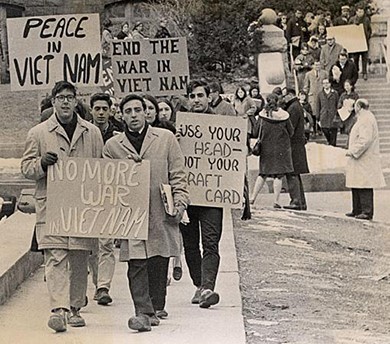
Students at the University of Wisconsin-Madison protested the war in Vietnam in 1965. Their actions were typical of many on college campuses across the country during the 1960s. Source: Wikimedia Commons
WOMEN’S RIGHTS
On the national scene, the civil rights movement was creating a climate of protest and claiming rights and new roles in society for people of color. Women played significant roles in organizations fighting for civil rights like SNCC and SDS. However, they often found that those organizations, enlightened as they might be about racial issues or the war in Vietnam, could still be influenced by patriarchal ideas of male superiority. Two members of SNCC, Casey Hayden and Mary King, presented some of their concerns about their organization’s treatment of women in a document entitled “On the Position of Women in SNCC.” Stokely Carmichael responded that the appropriate position for women in SNCC was “prone.”
Just as the abolitionist movement made nineteenth-century women more aware of their lack of power and encouraged them to form the first women’s rights movement, the protest movements of the 1960s inspired many white and middle-class women to create their own organized movement for greater rights. Not all were young women engaged in social protest. Many were older, married women who found the traditional roles of housewife and mother unfulfilling. In 1963, writer and feminist Betty Friedan published The Feminine Mystique in which she contested the post-World War II belief that it was women’s destiny to marry and bear children. Friedan’s book was a best-seller and began to raise the consciousness of many women who agreed that homemaking in the suburbs sapped them of their individualism and left them unsatisfied.
The Civil Rights Act of 1964, which prohibited discrimination in employment on the basis of race, color, national origin, and religion, also prohibited, in Title VII, discrimination on the basis of sex. Ironically, protection for women had been included at the suggestion of a Virginia congressman in an attempt to prevent the act’s passage; his reasoning seemed to be that, while a white man might accept that African Americans needed and deserved protection from discrimination, the idea that women deserved equality with men would be far too radical for any of his male colleagues to contemplate. Nevertheless, the act passed, although the struggle to achieve equal pay for equal work continues today.
Medical science also contributed a tool to assist women in their liberation. In 1960, the U.S. Food and Drug Administration approved the birth control pill, freeing women from the restrictions of pregnancy and childbearing. Women who were able to limit, delay, and prevent reproduction were freer to work, attend college, and delay marriage. Within five years of the pill’s approval, some six million women were using it.
The pill was the first medicine ever intended to be taken by people who were not sick. Even conservatives saw it as a possible means of making marriages stronger by removing the fear of an unwanted pregnancy and improving the health of women. Its opponents, however, argued that it would promote sexual promiscuity, undermine the institutions of marriage and the family, and destroy the moral code of the nation. By the early 1960s, thirty states had made it a criminal offense to sell contraceptive devices.
In 1966, the National Organization for Women (NOW) formed and proceeded to set an agenda for the feminist movement. Framed by a statement of purpose written by Friedan, the agenda began by proclaiming NOW’s goal to make possible women’s participation in all aspects of American life and to gain for them all the rights enjoyed by men. Among the specific goals was the passage of the Equal Rights Amendment (yet to be adopted).
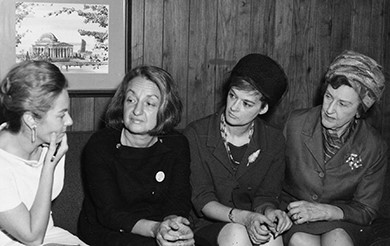
Early members of NOW discuss the problems faced by American women. Betty Friedan is second from the left. Source: Wikimedia Commons
More radical feminists, like their colleagues in other movements, were dissatisfied with merely redressing economic issues and devised their own brand of consciousness-raising events and symbolic attacks on women’s oppression. The most famous of these was an event staged in September 1968 by New York Radical Women. Protesting stereotypical notions of femininity and rejecting traditional gender expectations, the group demonstrated at the Miss America Pageant in Atlantic City, New Jersey, to bring attention to the contest’s—and society’s—exploitation of women. The protestors crowned a sheep Miss America and then tossed instruments of women’s oppression, including high-heeled shoes, curlers, girdles, and bras, into a “freedom trash can.” News accounts famously, and incorrectly, described the protest as a “bra burning.”
12.9 Section Summary
During the 1960s, many people rejected traditional roles and expectations. Influenced and inspired by the civil rights movement, college students of the baby boomer generation and women of all ages began to fight to secure a stronger role in American society. As members of groups like SDS and NOW asserted their rights and strove for equality for themselves and others, they upended many accepted norms and set groundbreaking social and legal changes in motion. Many of their successes continue to be felt today,
Summary Timelines
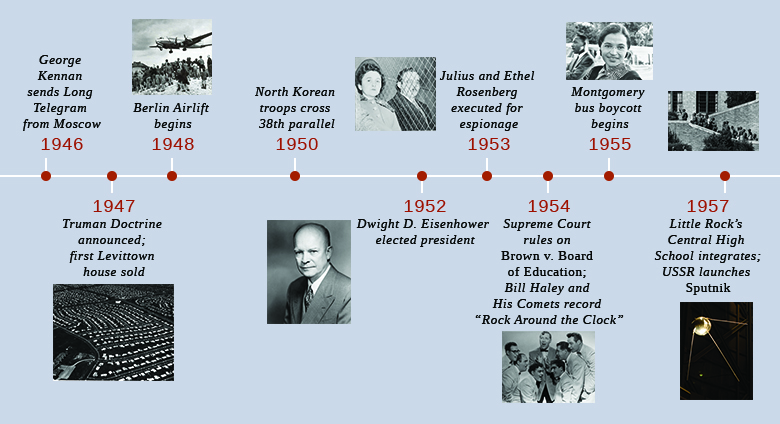
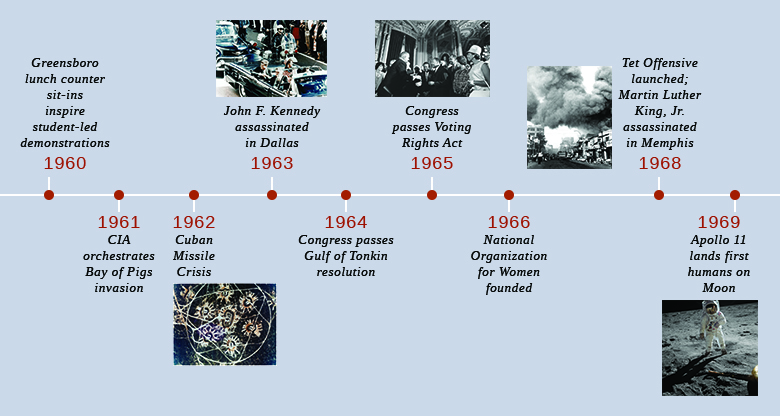
Chapter 12 Self-Test
Chapter 12 Key Terms Crossword Puzzle
Citations: This edited book is derivative of US History by P. Scott Corbett, et. al. CC BY 4.0. The original textbook is available at https://openstax.org/details/books/us-history
a program that gave substantial benefits to those who served in World War II
President Harry Truman’s program of economic and social reform
the prolonged period of tension between the United States and the Soviet Union, based on ideological conflicts and competition for military, economic, social, and technological superiority, and marked by surveillance and espionage, political assassinations, an arms race, attempts to secure alliances with developing nations, and proxy wars
the U.S. policy that sought to limit the expansion of Communism abroad
the theory that if Communism made inroads in one nation, surrounding nations would also succumb one by one, like a chain of dominos toppling one another
a program giving billions of dollars of U.S. aid to European countries to prevent them from turning to Communism
a defense strategy, sometimes called “mutually assured destruction” or MAD, adopted by Eisenhower that called for launching a large-scale nuclear attack on the Soviet Union in response to a first Soviet strike at the United States
the first manmade orbital satellite, launched by the Soviet Union in October 1957
a marked increase in the U.S. birthrate during 1946–1964
a musical form popular among the baby boomers that encompassed styles ranging from county to blues, and embraced themes such as youthful rebellion and love
a list of people suspected of having Communist sympathies who were denied work as a result
the removal of laws and policies requiring the separation of different racial or ethnic groups
the nickname for the nine African American high school students who first integrated Little Rock’s Central High School
the political belief that states possess authority beyond federal law, which is usually seen as the supreme law of the land, and thus can act in opposition to federal law
a military strategy that allows for the possibility of responding to threats in a variety of ways, including counterinsurgency, conventional war, and nuclear strikes
Lyndon Johnson’s plan to eliminate poverty and racial injustice in the United States and to improve the lives of all Americans
Lyndon Johnson’s plan to end poverty in the Unites States through the extension of federal benefits, job training programs, and funding for community development
the matrix of relationships between officials in the Defense Department and executives in the defense industry who all benefited from increases in defense spending
a political ideology encouraging African Americans to create their own institutions and develop their own economic resources independent of whites
an ideology that called upon African Americans to reject integration with the white community and, in some cases, to physically separate themselves from whites in order
a cultural movement among African Americans to encourage pride in their African heritage and to substitute African and African American art forms, behaviors, and cultural products for those of whites
the political manifesto of Students for a Democratic Society that called for social reform, nonviolent protest, and greater participation in the democratic process by ordinary Americans
the section of the Civil Rights Act of 1964 that prohibited discrimination in employment on the basis of gender
